Birds

Photo: Zebra Dove (Geopelia striata) (Credit: Ambarish Deshmukh
Jurong Lake Gardens is home to a wide diversity of birds. Birds play important ecological roles as predators, pollinators and seed dispersers. Get to the know the urban birds, kingfishers, raptors, waterbirds and woodpeckers that frequent our gardens!
Garden and Urban Birds
Singapore is home to many species of birds that have adapted to the city life, many of which frequent Jurong Lake Gardens.
Brown-throated Sunbird
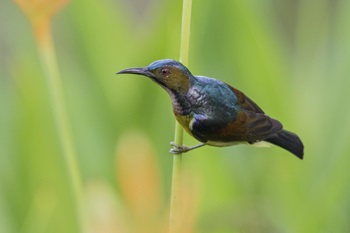
Male. Photo: Loke Peng Fai
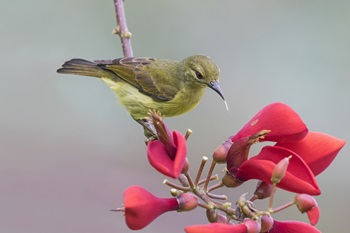
Female. Photo: Loke Peng Fai
|
Scientific name: |
Anthreptes malacensis |
|
Common name: |
Brown-throated Sunbird |
|
Family: |
Nectariniidae |
What does it look like?
While the Western Hemisphere has hummingbirds (Family Trochilidae), Africa and Asia have sunbirds, which are also primarily nectar-feeders. Brown-throated Sunbirds are relatively large compared to other sunbirds. Males have a brown throat, with a metallic green head and neck, purple wings and lemon yellow belly. The females are dull olive in colour. Both sexes have red eyes.
Ecology, Habitat and Distribution
Diet and Behaviour
Their primary diet is nectar, but they will also feed on invertebrates, particularly spiders. These birds are often seen visiting flowering trees and shrubs in search of nectar. Like other sunbirds, they make pouch-shaped nests that are suspended from tree branches using leaves, grass and spiders’ web.
Where are they found?
A very common sunbird, it is found in many habitats in Singapore and throughout Southeast Asia.
Olive-backed Sunbird
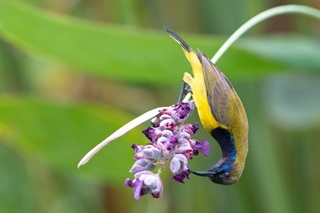
Male. Photo: Francis Yap
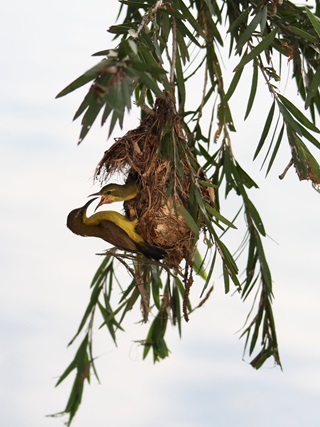
Female and chick in nest. Photo: Perlyn Chng
|
Scientific name: |
Cinnyris jugularis |
|
Common name: |
Olive-backed Sunbird |
|
Family: |
Nectariniidae |

12cm
What does it look like?
In addition to the Brown-throated Sunbird, the Olive-backed Sunbird is the other sunbird that can be commonly seen in our parks and gardens. Both males and females have a dull olive brown back with yellow underparts, but the males also have a metallic blue forehead, throat and upper breast. This species has a longer, more curved beak than the Brown-throated Sunbird.
Ecology, Habitat and Distribution
Diet and Behaviour
They feed on nectar but will also prey on insects, especially when feeding their young. These birds are often seen in pairs visiting flowering shrubs and trees. They are more often seen in flowering shrubs compared to the Brown-throated Sunbird. Like other sunbirds, they make pouch-shaped nests that are suspended from tree branches using leaves, grass and spiders’ web.
Where are they found?
The Olive-backed Sunbird is very commonly seen in our urban areas and are very tolerant of humans. Some are even bold enough to make their nests on potted plants in HDB blocks! They are also found across southern China, Southeast Asia, northeast Australia and the Solomon Islands.
Did you know?
The nests of Olive-backed Sunbirds are often a source of fascination for Singaporeans as they regularly nest in residential areas such as balconies and along the corridors of HDB estates.
Scarlet-backed Flowerpecker
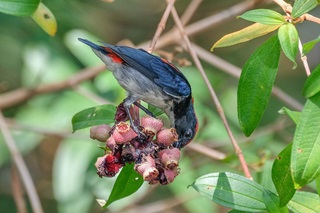
Male. Photo: Soh Chui Lian
|
Scientific name: |
Dicaeum cruentatum |
|
Common name: |
Scarlet-backed Flowerpecker |
|
Family: |
Dicaeidae |

9 cm
What does it look like?
The male Scarlet-backed Flowerpecker is very distinctive with its bright red upperparts, a blackish head, and bluish black wings which contrast with its white underparts. The female is a drab olive brown with white underparts and a bright red rump. It is one of Singapore’s smallest birds!
Ecology, Habitat and Distribution
Diet and Behaviour
These birds feed on a variety of food including berries and insects, but they are particularly fond of mistletoe fruits. They build a pouch-shaped nest with a side entrance and hang it from a high tree branch, similar to the sunbird.
Where are they found?
These birds are found in many habitats throughout Singapore. They are also distributed across the Indian subcontinent, China and Southeast Asia.
Did you know?
Its scientific name, cruentatum, is derived from the Latin verb that means ‘bloodstained’, referring to the scarlet backs of males.
Asian Koel
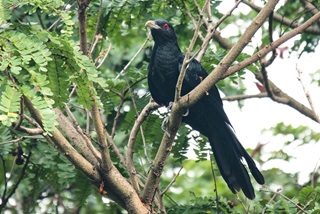
Male. Photo: Jeremy Yeo Wei Liang
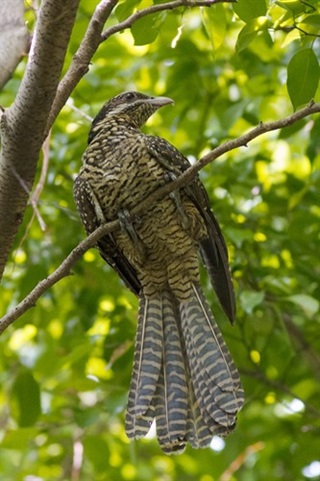
Female. Photo: Francis Yap, NParks Flora & Fauna Web
|
Scientific name: |
Eudynamus scolopacea |
|
Common name: |
Asian Koel |
|
Family: |
Cuculidae |

44 cm
What does it look like?
This member of the cuckoo family is a large bird that has bright red eyes and a pale beak. The males have an entirely glossy black plumage, while females are brown with white and light brown spots.
Ecology, Habitat and Distribution
Diet and Behaviour
They are omnivores and feed on a variety of food. Like other cuckoos, they are brood parasites that lay their eggs in the nests of other birds, relying on the unsuspecting foster parents to raise their chicks. In Singapore, their host is the introduced House Crow (Corvus splendens). As the koel chicks hatch and force the crow chicks out of the nest, the Asian Koel acts as an important natural control for Singapore’s crow population.
Where are they found?
These birds are found in a wide range of habitats from urban areas to secondary forests.
Did you know?
They are infamous for their namesake loud, high pitched ‘ko-el’ call which can be heard at any time of the day.
Pink-necked Green Pigeon
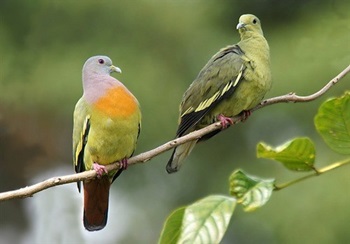
Male (left) and female (right). Photo: Cai Yixiong, NParks Flora & Fauna Web
|
Scientific name: |
Treron vernans |
|
Common name: |
Pink-necked Green Pigeon |
|
Family: |
Columbidae |

25–30 cm
What does it look like?
It is sexually dimorphic, and males can be easily distinguished by their bright pink neck and orange lower breast. Females are uniformly green.
Ecology, Habitat and Distribution
Diet and Behaviour
They are frugivorous, with large flocks often gathering at fruiting trees. They feed on a wide variety of fruits, making them important seed dispersers. They are arboreal and generally prefer to perch on branches of tall trees. Both males and females are involved in the incubation of eggs and care of young chicks.
Where are they found?
These birds can be found in our forests, mangroves, parks and urban areas. They are widespread throughout Southeast Asia.
Zebra Dove
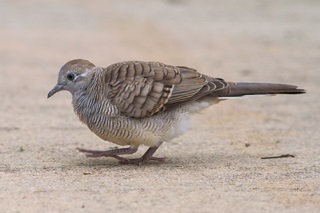
Photo: Francis Yap
|
Scientific name: |
Geopelia striata |
|
Common name: |
Zebra Dove |
|
Family: |
Columbidae |

20–23 cm
What does it look like?
The upperparts of this small and slender dove are brownish grey with black and white bars. Its underparts are pinkish, with black bars on the sides of its neck, breast and belly. Its forehead, face and throat are a pale grey, with blue around the eyes.
Ecology, Habitat and Distribution
Diet and Behaviour
Small flocks are often seen quietly foraging on footpaths and lawns in search of grass seeds, which are a main part of their diet. Their nests consist of a simple platform of leaves and grass blades.
Where are they found?
The Zebra Dove is widespread across Singapore and is often seen in urban areas and grasslands. They are found across Southeast Asia.
Did you know?
They are popular pets due to their pleasant call of soft, short ‘coo’ notes. There are even competitions to find the zebra dove with the best-sounding call!
Blue-tailed Bee-eater
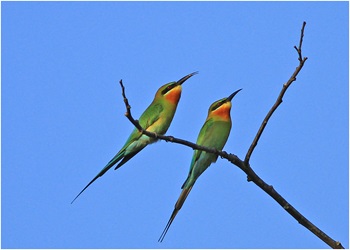
Photo: Ong Chwee Sia
|
Scientific name: |
Merops philippinus |
|
Common name: |
Blue-tailed Bee-eater |
|
Family: |
Meropidae |

30 cm (head to streamer)
What does it look like?
It has a long, slightly down-curved black bill, is predominantly greenish in colour and has blue tail feathers with long tail-streamers. Adults have an orange throat with a black eye stripe.
Ecology, Habitat and Distribution
Diet and Behaviour
These birds feed on a variety of flying insects such as dragonflies, bees and large flies which are caught mid-flight. They like to perch on branches of tall, exposed trees and even antennae when searching for prey. When they catch a bee, they beat it against a branch to remove its sting before consuming it whole.
Where are they found?
These birds are migratory and can be commonly found in a wide range of habitats between the months of October and April. They breed in northern Asia and migrate south during the northern winter months.
Blue-throated Bee-eater
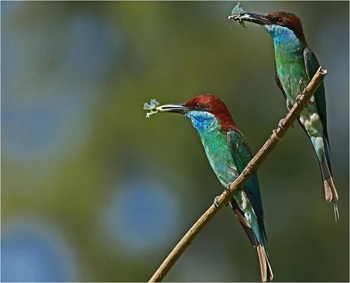
Photo: Ong Chwee Sia
|
Scientific name: |
Merops viridis |
|
Common name: |
Blue-throated Bee-eater |
|
Family: |
Meropidae |

28 cm (head to streamer)
What does it look like?
A mix of brown, green and blue makes this bee-eater easy to identify. Adult Blue-throated Bee-eaters have mostly bluish green bodies with a dark chestnut crown, black eye stripe and namesake blue throat.
Ecology, Habitat and Distribution
Diet and Behaviour
Its diet and behaviour are largely similar to that of the migratory Blue-tailed Bee-eater.
Where are they found?
This species differs from the migratory Blue-tailed Bee-eater in that it breeds in Singapore and disperses to Indonesia during the non-breeding season. They are mainly found in wooded areas and grasslands. This species is also present in many parts of Southeast Asia.
Did you know?
They practise asynchronous brooding, where chicks hatch at different times. This often results in siblicide, where the oldest and largest chick often competes with its younger siblings for food, usually wounding or even killing them.
Rose-ringed Parakeet
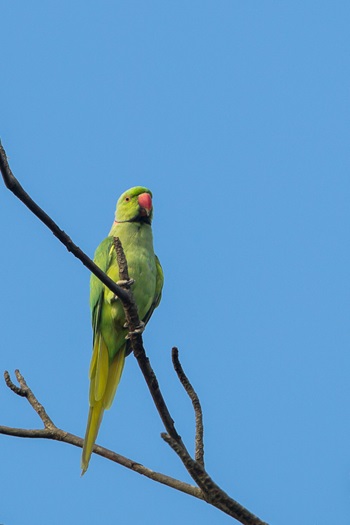
Male. Photo: Francis Yap, NParks Flora & Fauna Web
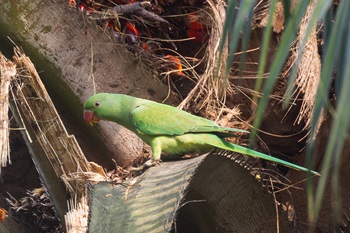
Female. Photo: Francis Yap, NParks Flora & Fauna Web
|
Scientific name: |
Psittacula krameri |
|
Common name: |
Rose-ringed Parakeet |
|
Family: |
Psittacidae |

42 cm
What does it look like?
It is sexually dimorphic. The male has a distinct black neck ring, which is not present in females.
Ecology, Habitat and Distribution
Diet and Behaviour
They are frugivores that feed on a wide range of fruits.
Where are they found?
This is an introduced species which originated with escapees from the pet trade. They are now widely distributed across Singapore. Their native range includes the Indian Subcontinent and northern Southeast Asia, but feral populations exist in many other countries.
Yellow-vented Bulbul
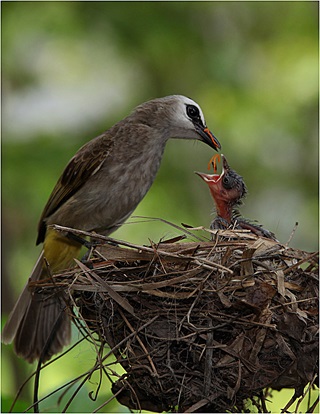
Photo: Ong Chwee Sia
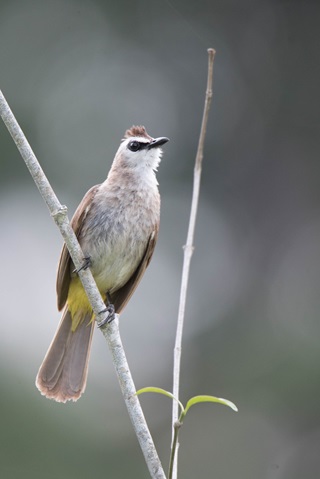
Photo: Jeremy Yeo Wei Liang
|
Scientific name: |
Pycnonotus goiavier |
|
Common name: |
Yellow-vented Bulbul |
|
Family: |
Pycnonotidae |

20 cm
What does it look like?
As its name implies, it has a yellow vent on the underside of its tail. It is otherwise mainly brown but has a white face with a black band between the eyes and the bill.
Ecology, Habitat and Distribution
Diet and Behaviour
They are omnivores that feed on berries, nectar and small animals. They are often seen in pairs foraging for food. They build well-camouflaged cup-shaped nests out of plant matter.
Where are they found?
They can be found in a wide variety of habitats across Singapore and throughout Southeast Asia.
Did you know?
The name “Bulbul” comes from an Arabic word meaning “Nightingale”, which alludes to their bubbly calls. However, bulbuls are not related to nightingales.
Malaysian Pied Fantail
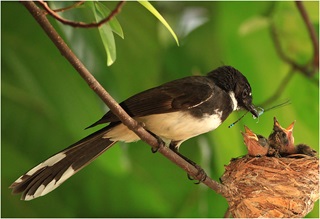
Photo: Ong Chwee Sia
|
Scientific name: |
Rhipidura javanica |
|
Common name: |
Malaysian Pied Fantail |
|
Family: |
Rhipiduridae |

17.5–19.5 cm
What does it look like?
Like other members of its family, this bird has a distinctive fan-shaped tail. It has largely black upperparts and white underparts with a broad black band across its breast.
Ecology, Habitat and Distribution
Diet and Behaviour
These birds move rapidly through the understorey, fanning their tails as they go. They are often seen foraging together with other small insect-eating birds.
Where are they found?
Once found primarily in mangroves, this species has colonised many parks in Singapore, particularly those with large, wooded water bodies like Jurong Lake Gardens. They are also widely distributed across many parts of Southeast Asia.
Did you know?
The Malaysian Pied Fantail is called Murai Gila, or “crazy thrush” in Malay due to its disjointed song and frantic feeding behaviour.
Asian Glossy Starling
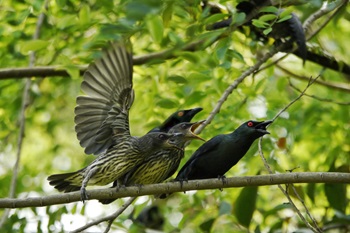
Photo: Perlyn Chng
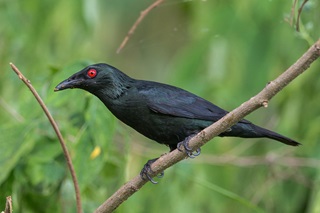
Photo: Francis Yap
|
Scientific name: |
Aplonis panayensis |
|
Common name: |
Asian Glossy Starling |
|
Family: |
Sturnidae |

22–25 cm
What does it look like?
Adults have a uniformly glossy green plumage that appears black in poor light. Its distinctive feature is its bright red eyes. Juveniles are greyish brown with white underparts that sport bold dark streaks. They may look similar to the Asian Koel at first glance but are much smaller in size with shorter tails.
Ecology, Habitat and Distribution
Diet and Behaviour
These highly social omnivores often congregate in large, noisy flocks in fruiting trees.
Where are they found?
One of Singapore’s most abundant birds, the Asian Glossy Starling occurs in all habitats across the island. It is widely distributed across Southeast Asia.
Savanna Nightjar
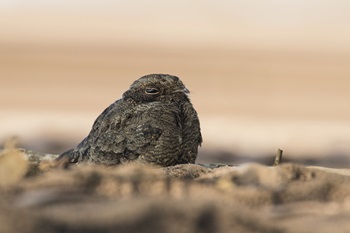
Photo: Loke Peng Fai
|
Scientific name: |
Caprimulgus affinis |
|
Common name: |
Savanna Nightjar |
|
Family: |
Caprimulgidae |

25 cm
What does it look like?
This nocturnal bird has large eyes and brownish grey upperparts irregularly interspersed with pale brown speckles. Its underparts are brown with numerous fine bars.
Ecology, Habitat and Distribution
Diet and Behaviour
These nocturnal birds hunt for flying insects and are rarely spotted in the day when sleeping motionless on the ground. Their plumage provides excellent camouflage among the leaf litter, keeping them concealed while they roost.
Where are they found?
They are mainly found in grasslands and open country and are distributed across the Indian Subcontinent and Southeast Asia.
Did you know?
They lay their eggs directly on the ground in grasslands, so watch your step when you are walking across an open grassland! The Grasslands at Jurong Lake Gardens was created specially to cater to birds like the Savanna Nightjar.
Brown Shrike
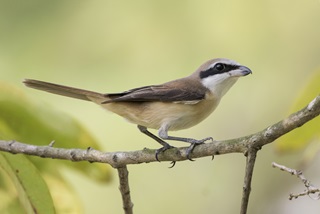
Photo: Loke Peng Fai
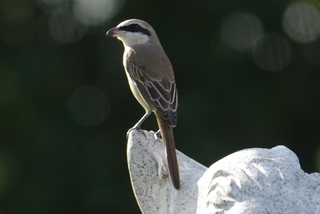
Photo: Perlyn Chng
|
Scientific name: |
Lanius cristatus |
|
Common name: |
Brown Shrike |
|
Family: |
Laniidae |

19–20 cm
What does it look like?
This migratory bird sports a distinctive “bandit mask” comprising a black stripe through its eyes. It has brown upperparts with a creamy underside and rufous flanks. Females tend to have fine scalloping on their undersides and a dark brown mask.
Ecology, Habitat and Distribution
Diet and Behaviour
They feed on a range of small animals from insects to rats.
Where are they found?
Brown Shrikes breed in northern and eastern Asia and fly down to spend the winter in the Indian subcontinent and Southeast Asia. They are commonly seen in Singapore during the winter months. They prefer open habitats like parks and grasslands.
Did you know?
They are stone-cold killers that impale their prey! They skewer their prey on the thorns of plants and eat them like meat on a satay stick.
Common Tailorbird
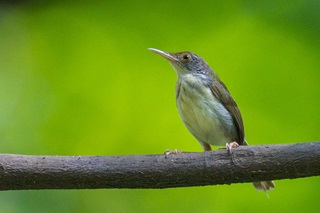
Photo: Francis Yap
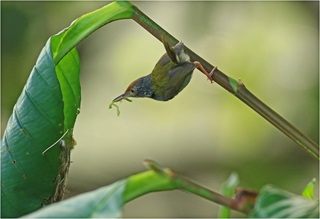
Weaving its nest. Photo: Ong Chwee Sia
|
Scientific name: |
Orthotomus sutorius |
|
Common name: |
Common Tailorbird |
|
Family: |
Cisticolidae |

10–13 cm
What does it look like?
The Common Tailorbird is a small bird that has olive brown upperparts and wings with a rufous patch on the head between its eyes and beak. A male in breeding plumage also has an elongated tail and a dark patch on its neck.
Ecology, Habitat and Distribution
Diet and Behaviour
These small, active birds are insectivores that forage in dense shrubbery in search of prey. They get their name from their unique method of making their nests by weaving and sewing the edges of two large leaves together using plant fibre or spider silk.
Where are they found?
A common garden bird, they are found throughout Singapore. They have a widespread range that includes both the Indian Subcontinent and Southeast Asia.
Did you know?
The character Darzee in “Rikki-Tikki-Tavi”, one of the stories in the Jungle Book series by Rudyard Kipling, is a tailorbird. The name “Darzee” comes from the Urdu word for tailor.
Ashy Tailorbird
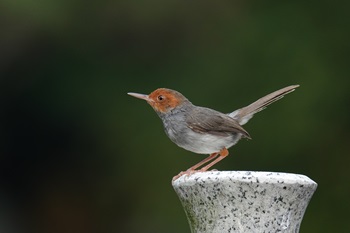
Photo: Tan Yip Cheong
|
Scientific name: |
Orthotomus ruficeps |
|
Common name: |
Ashy Tailorbird |
|
Family: |
Cisticolidae |

11 cm
What does it look like?
The Ashy Tailorbird is a small bird that has slate grey plumage with a chestnut patch on its face, and a white belly. Females have a much duller colouration.
Ecology, Habitat and Distribution
Diet and Behaviour
They have similar eating and behavioural habits to the Common Tailorbird.
Where are they found?
The Ashy Tailorbird was originally a mangrove species but has adapted well to urban wetlands. They are now found in many parks containing water bodies such as Jurong Lake Gardens. Elsewhere, they are widely distributed across Southeast Asia.
Pacific Swallow
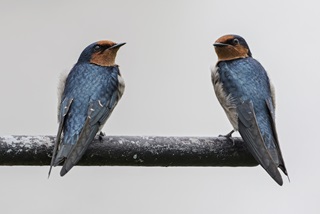
Photo: Loke Peng Fai

Photo: Perlyn Chng
|
Scientific name: |
Hirundo tahitica |
|
Common name: |
Pacific Swallow |
|
Family: |
Hirundinidae |

13 cm
What does it look like?
The only resident species of swallow in Singapore, it sports metallic blue upperparts with an orange forehead, throat and upper breast. It is mostly spotted in flight, often in small groups.
Ecology, Habitat and Distribution
Diet and Behaviour
It is a fast flyer that feeds on insects while airborne. Its neat, cup-shaped nest is built with mud pellets under a cliff ledge or on man-made structures like buildings, bridges and towers.
Where is it found?
The Pacific Swallow has a wide distribution across much of the Eastern Hemisphere. In Singapore, it is a common resident that is found in many habitats.
Common Iora
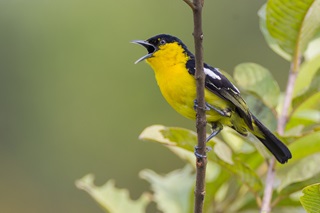
Male. Photo: Francis Yap
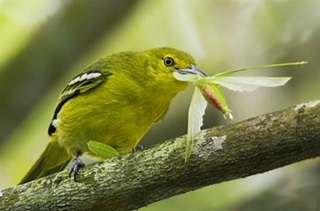
Female. Photo: Cai Yixiong, NParks Flora & Fauna Web
|
Scientific name: |
Aegithina tiphia |
|
Common name: |
Common Iora |
|
Family: |
Aegithinidae |

12–14 cm
What does it look like?
It is sexually dimorphic, with the bright yellow males sporting a black cap and back during breeding season, while females are entirely olive green. Both sexes have yellow underparts and two white bars on their black wings.
Ecology, Habitat and Distribution
Diet and Behaviour
They actively forage for food in the canopy, moving through the crowns of trees while looking for insects.
Where are they found?
It is common in our parks and gardens and can be seen along the tree-lined roads in our heartlands as well.
The Common Iora can be found in the Indian subcontinent, southwest China and Southeast Asia in mangroves, secondary growth and parks.
Black-naped Oriole
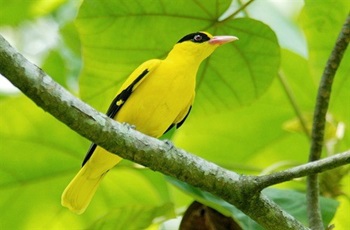
Photo: Cai Yixiong, NParks Flora & Fauna Web
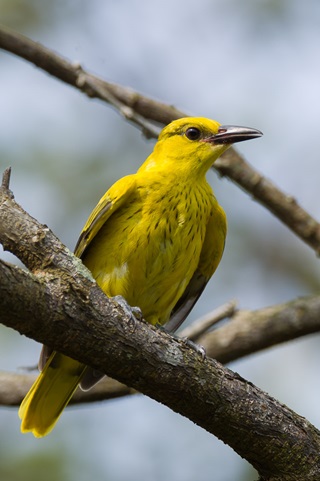
Photo: Francis Yap
|
Scientific name: |
Oriolus chinensis |
|
Common name: |
Black-naped Oriole |
|
Family: |
Oriolidae |

27 cm
What does it look like?
One of the most common bird species in Singapore, the Black-naped Oriole has bright yellow plumage with some black on its wings and a pinkish bill. Its name comes from a black band across its eyes that runs down to its nape. Females have a slightly greener tinge. Their calls are a melodious ‘too-diddlyoo’ whistle, but they also make harsh rasping noises at times.
Ecology, Habitat and Distribution
Diet and Behaviour
The Black-naped Oriole feeds mainly on fruits and insects.
Where is it found?
It can be seen in wooded habitats all over the island. It can also be found in South Asia and many parts of Southeast Asia.
Did you know?
Black-naped Orioles have a dark side to them! During breeding season, they are skilled nest raiders that snatch unguarded chicks from the nests of smaller birds to feed to their own young.
Oriental Pied Hornbill
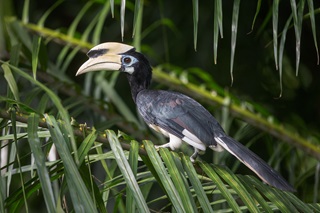
Photo: Francis Yap
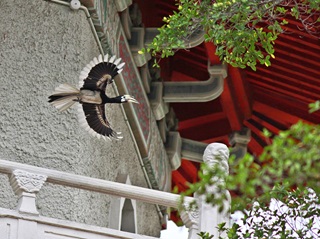
Photo: Perlyn Chng
|
Scientific name: |
Anthracoceros albirostris |
|
Common name: |
Oriental Pied Hornbill |
|
Family: |
Bucerotidae |

70 cm
What does it look like?
These large birds are unmistakable. Both sexes are largely black with a white belly. Males have a very pronounced black-tipped casque on its clean yellowish bill. Females have a much smaller casque with black patches.
Ecology, Habitat and Distribution
Diet and Behaviour
They feed mainly on fruits but are also known to feed on insects and other small animals. They are important to the ecosystem as they disperse seeds that are too large for smaller bird species to eat.
Oriental Pied Hornbills are gregarious and often travel in noisy flocks. They require a large tree to nest. The female seals herself inside a suitably sized hole in a tree with a plaster made of mud and plant fibres. The male forages for food alone, while the female guards the nest to deter predators from stealing their eggs for food.
Where are they found?
The Oriental Pied Hornbill has a wide distribution from the Indian Subcontinent to Southeast Asia. In Singapore, the species is a prime example of successful conservation efforts. It was rediscovered on Pulau Ubin in 1994 and is now found across most of Singapore.
Did you know?
The Singapore Hornbill Project was initiated in 2004 by NParks, Jurong Bird Park and local researchers with the goal of bringing hornbills back to Singapore. The project was extremely successful and by the time it ended in 2012, the Oriental Pied Hornbill had become a well-known and endearing avian icon.
Conservation Status
It is listed as Critically Endangered in the Singapore Red Data Book (2008). After an absence of over a century, a pair was observed on Pulau Ubin in 1994. Thanks to extensive conservation efforts, the local hornbill population is on the rise.
Oriental Magpie-Robin
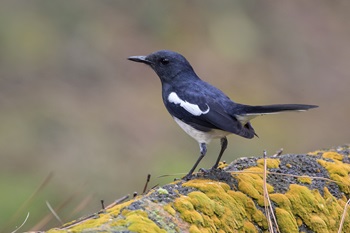
Photo: Loke Peng Fai
|
Scientific name: |
Copsychus saularis |
|
Common name: |
Oriental Magpie-Robin |
|
Family: |
Muscicapidae |

19 cm
What does it look like?
It has distinctive black and white plumage that resembles a magpie. Males have a glossy black head, breast and upperparts, while the rest of the underparts are white. It also has a distinct white wing bar. Females are similar to males but have a slate grey head, breast and upperparts.
Ecology, Habitat and Distribution
Diet and Behaviour
It forages on insects mainly on the ground, where it can be seen hopping around with its tail raised.
Where are they found?
This bird is widely distributed across Southeast Asia. In Singapore, they used to be a popular cage bird and were heavily trapped. In more recent times, the population appears to be recovering and they are now present in many parks and wooded areas.
Conservation Status
It is listed as Endangered in the Singapore Red Data Book (2008). In recent years, the local population appears to be gradually increasing.
Javan Myna
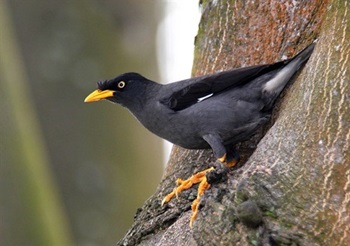
Photo: Cai Yixiong, NParks Flora & Fauna Web
|
Scientific name: |
Acridotheres javanicus |
|
Common name: |
Javan Myna |
|
Family: |
Sturnidae |

24–25 cm
What does it look like?
The Javan Myna is Singapore’s most recognisable bird. It has slate grey plumage with a glossy black head, wings and tail. Its eyes, bill and feet are orange yellow.
Ecology, Habitat and Distribution
Diet and Behaviour
They have adapted well to the urban environment by exploiting food sources such as leftover food in hawker centres and food waste. Outside of urban environments, they forage for insects and other invertebrates on the ground by probing the soil with their bills.
Where are they found?
In Singapore, it is by far the most abundant bird and occurs in all habitats. The Javan Myna is not native to Singapore but was introduced from Java and Bali. The introduced population has since colonised most of Peninsular Malaysia and southern Thailand.
Did you know?
Ironically, this bird is very rare in its native range of Java and Bali as it is heavily trapped for the pet trade there.
Conservation Status
This bird is classified as “Vulnerable” by the IUCN as it is heavily trapped by humans in its native range, despite being regarded as an introduced pest in Singapore.
Common Myna
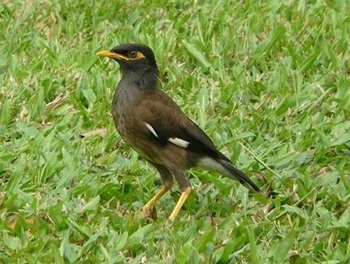
Photo: Cheryl Chia, NParks Flora & Fauna Web
|
Scientific name: |
Acridotheres tristis |
|
Common name: |
Common Myna |
|
Family: |
Sturnidae |

24–27 cm
What does it look like?
While similar to the more common Javan Myna, this species has brown, not slate grey plumage, and has prominent yellow facial skin around the eye. When juveniles moult their head feathers, they often look bald, causing many to mistake them for sick birds.
Ecology, Habitat and Distribution
Diet and Behaviour
It feeds mainly on the ground for insects and leftover scraps. It isn’t picky about its nesting sites and will use any cavity where it can pile nesting material into, including cracks in buildings or air conditioning units.
Where are they found?
These birds are native to the Indian subcontinent and Southeast Asia. They are also native to Singapore and are found in a wide variety of habitats, but in far smaller numbers than the Javan Myna.
Did you know?
The Common Myna, contrary to its name, is not common in Singapore and is largely outcompeted by the introduced and more aggressive Javan Myna.
Kingfishers
Kingfishers, true to their name, are master fishers that swoop down to catch prey with pinpoint accuracy. However, many species do not live close to water and therefore also feed on a wide variety of small animals.
These birds can be quite conspicuous due to their bright colouration and distinctive cackling calls. Take a listen when walking by a body of water and you may hear the calls of some of the featured species below!
Common Kingfisher
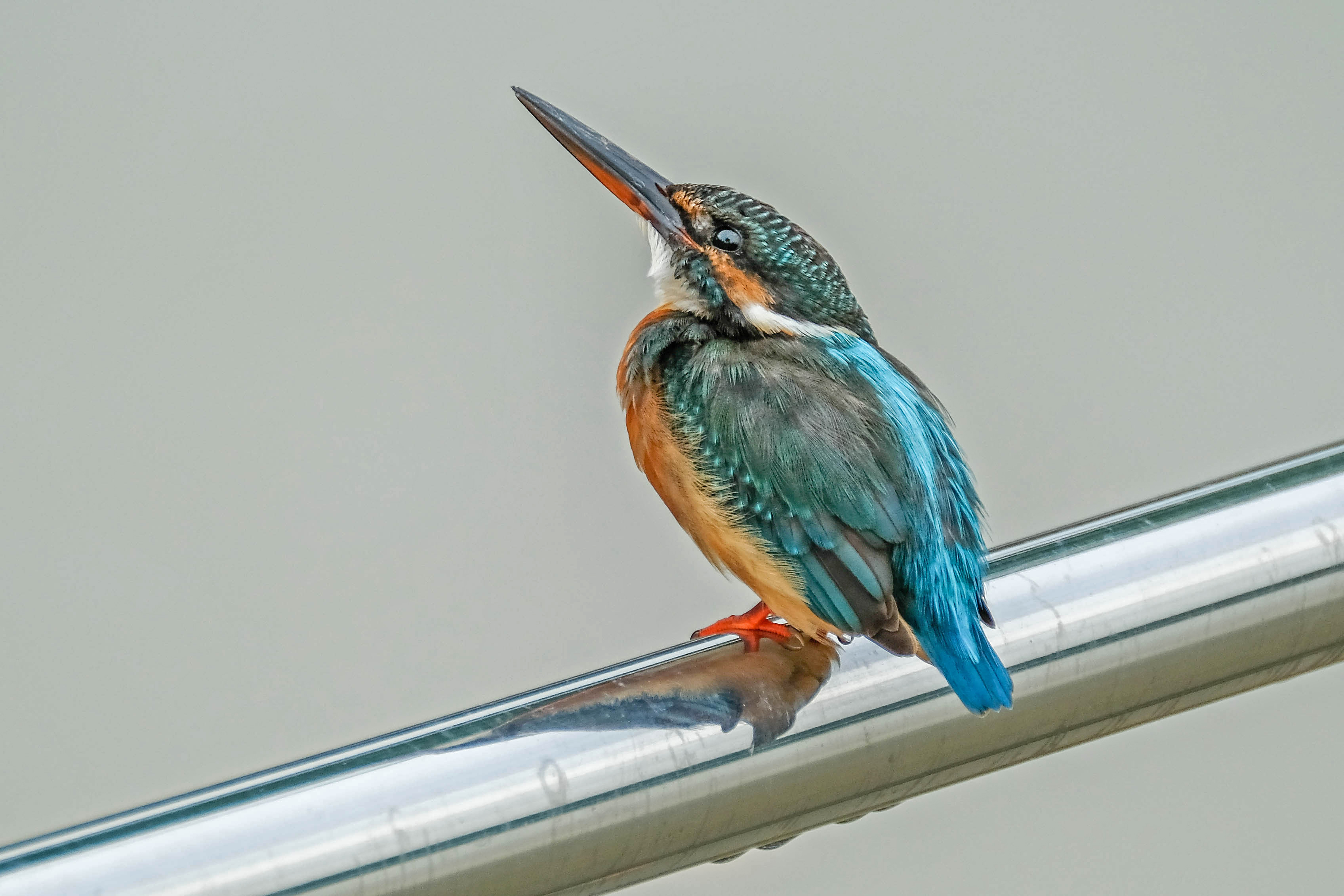
Photo credit: Soh Chui Lian
|
Scientific name: |
Alcedo atthis |
|
Common name: |
Common Kingfisher |
|
Family: |
Alcedinidae |
What does it look like?
A small kingfisher about the length of a small ruler, it is characterised by predominantly blue plumage with orange brown underparts. Males have an all-black bill, while females have an orange lower bill.
Ecology, Habitat and Distribution
Diet and Behaviour
They are often observed perching on vantage points overlooking water bodies such as stakes, signboards and even handrails. They feed predominantly on fish, which they catch by diving off these vantage points into the water.
Where are they found?
This species is found across Europe and Asia. In Singapore, it is migratory and occurs between the months of August and April, during which it can be observed in both freshwater and coastal wetlands.
Collared Kingfisher
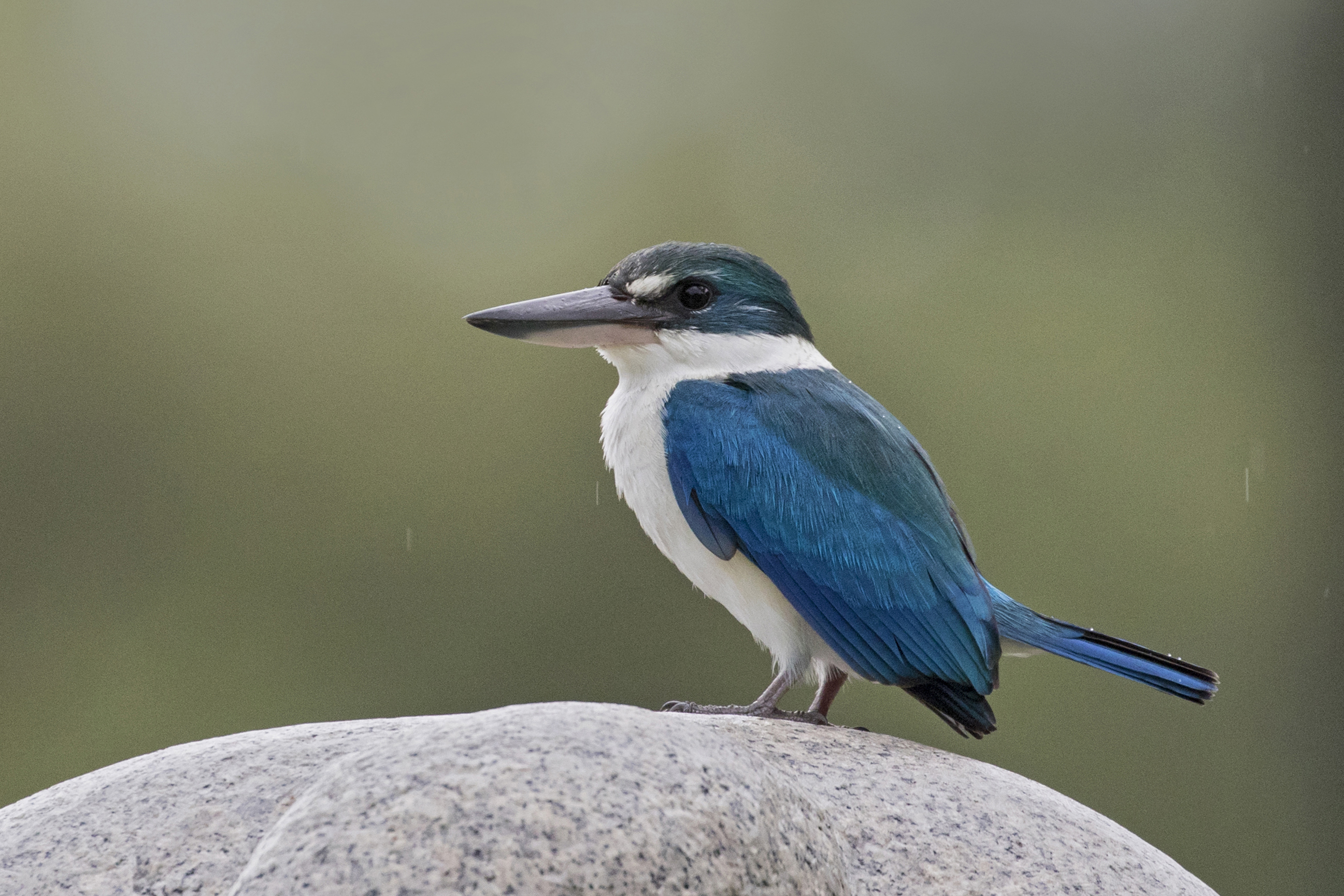
Photo credit: Loke Peng Fai
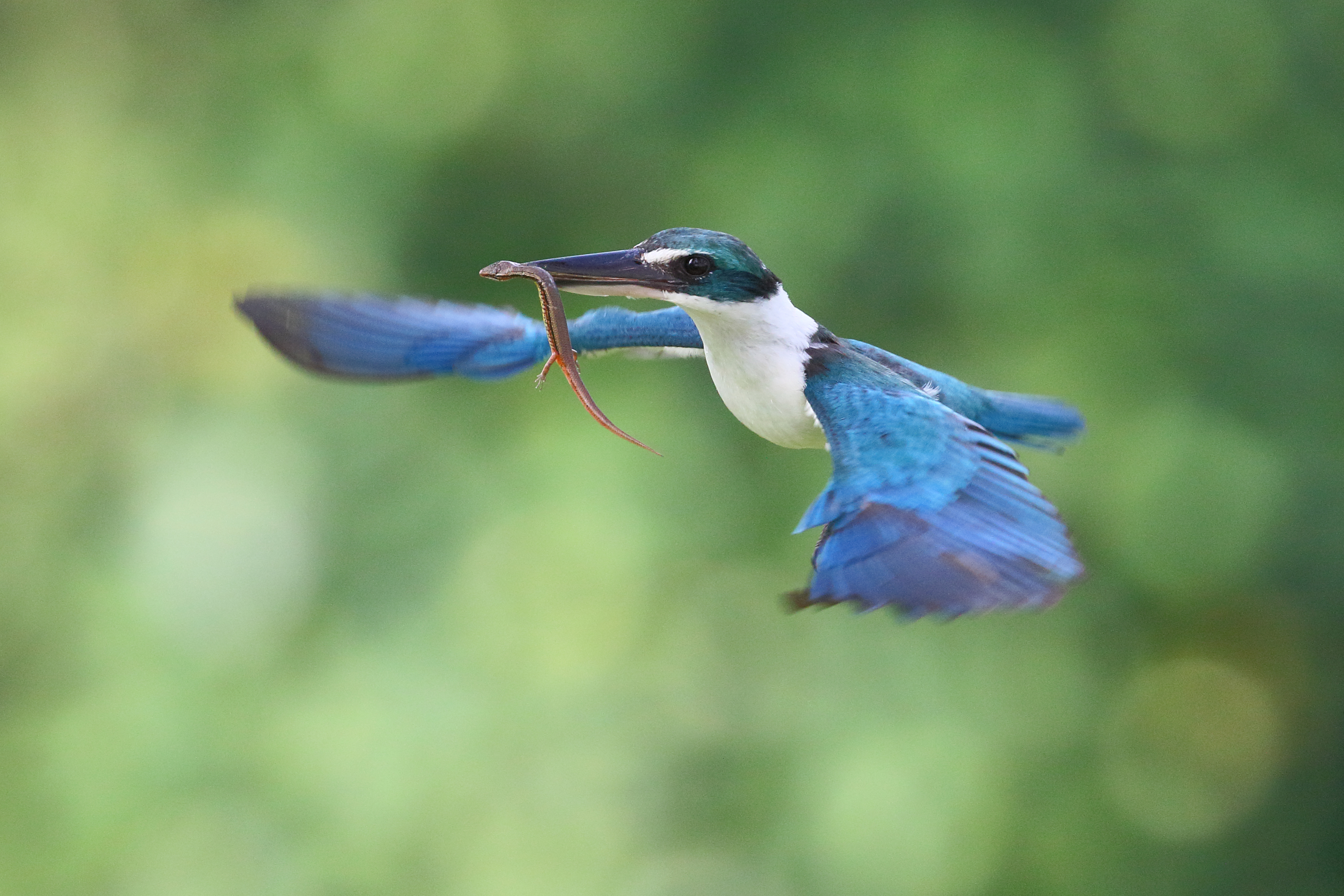
Photo credit: Loke Peng Fai
|
Scientific name: |
Todiramphus chloris |
|
Common name: |
Collared Kingfisher |
|
Family: |
Alcedinidae |
What does it look like?
The Collared Kingfisher is distinguished from other kingfishers by a white band around its neck and white underparts, with a turquoise blue back and wings.
Ecology, Habitat and Distribution
Diet and Behaviour
Singapore’s most abundant kingfisher, it feeds on a wide variety of small animals and often gives away its presence with its loud cackling calls.
Where are they found?
This species is found in all habitats throughout Singapore, including urban areas far from water. Globally, it is distributed across much of the Old World from Africa and the Middle East to Southeast Asia and Australia.
Did you know?
It is featured on the Singapore $10 banknote in the bird series, the second of four different series of the Singapore currency.
White-throated Kingfisher
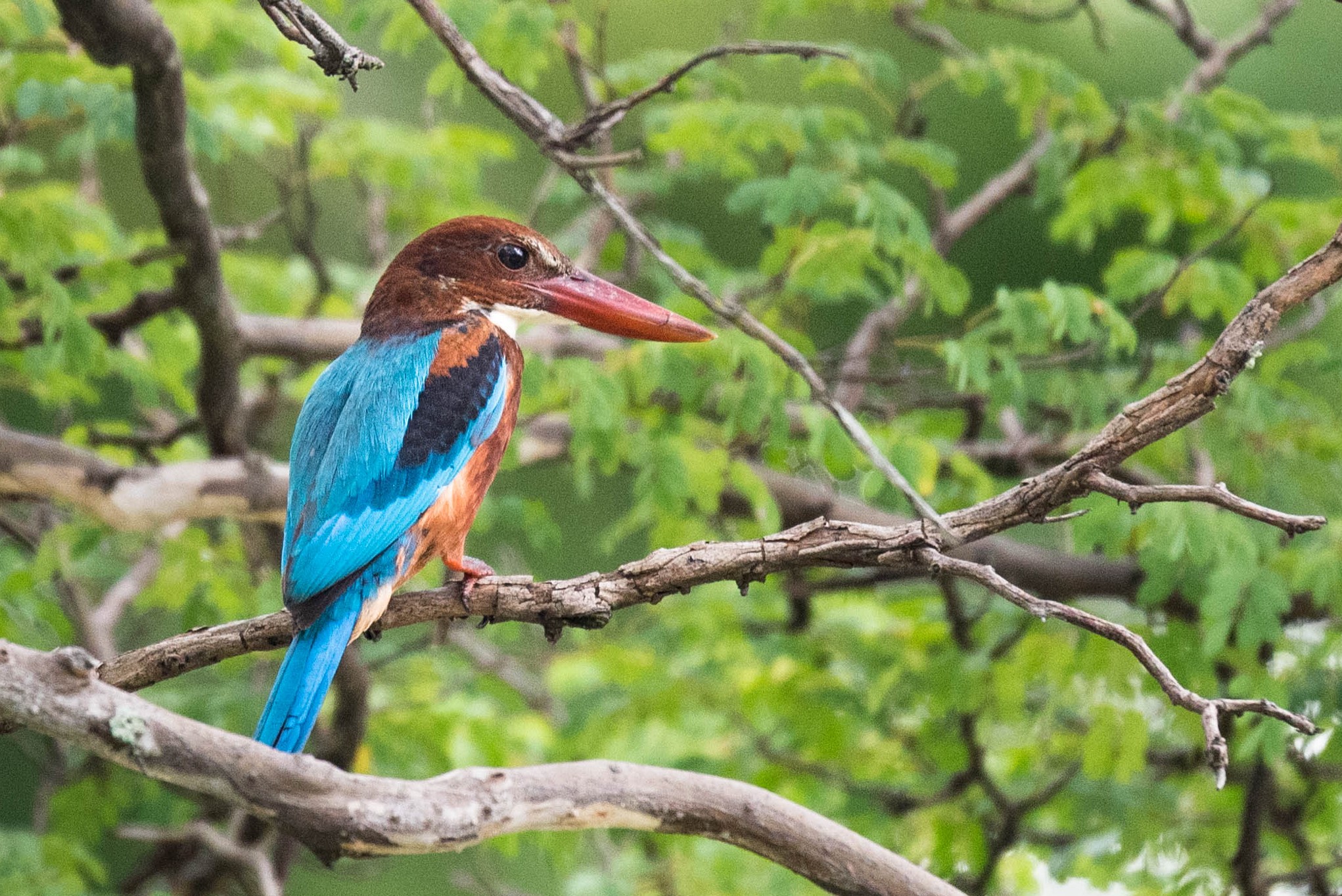
Photo credit: Jeremy Yeo Wei Liang (NParks)
|
Scientific name: |
Halcyon smyrnensis |
|
Common name: |
White-throated Kingfisher |
|
Family: |
Alcedinidae |
What does it look like?
It is easily identified by its distinctive white throat and breast, which contrast with its bright blue wings, back and tail, and chestnut head and belly.
Ecology, Habitat and Distribution
Diet and Behaviour
Like most kingfishers, it is often perched on vantage points looking for prey. It is usually seen close to water bodies, unlike the Collared Kingfisher.
Where are they found?
Like the Collared Kingfisher, this species has adapted to a wide variety of habitats in Singapore and is commonly encountered across the island. It is also widely distributed across Asia.
Stork-billed Kingfisher
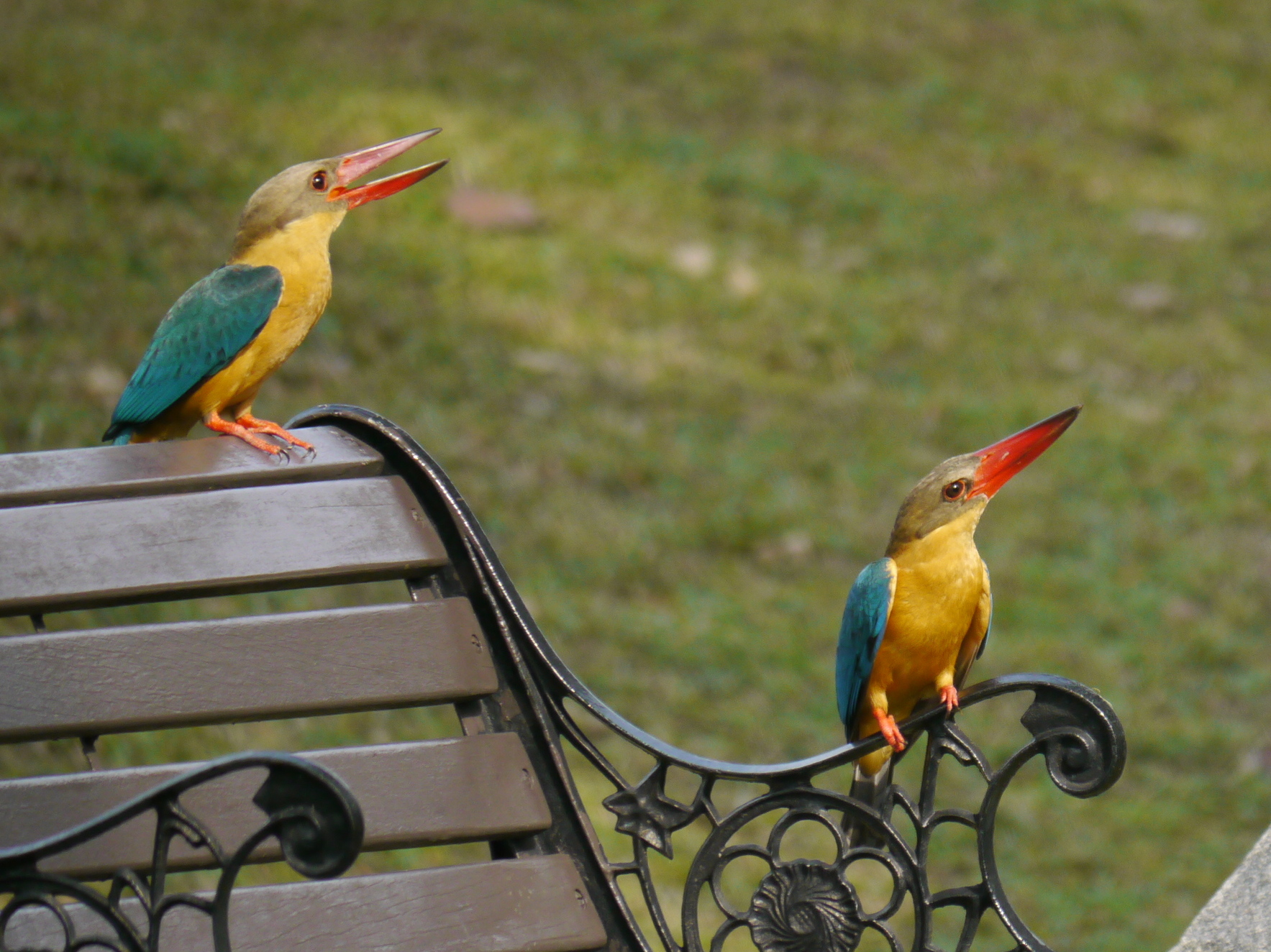
Photo credit: Perlyn Chng
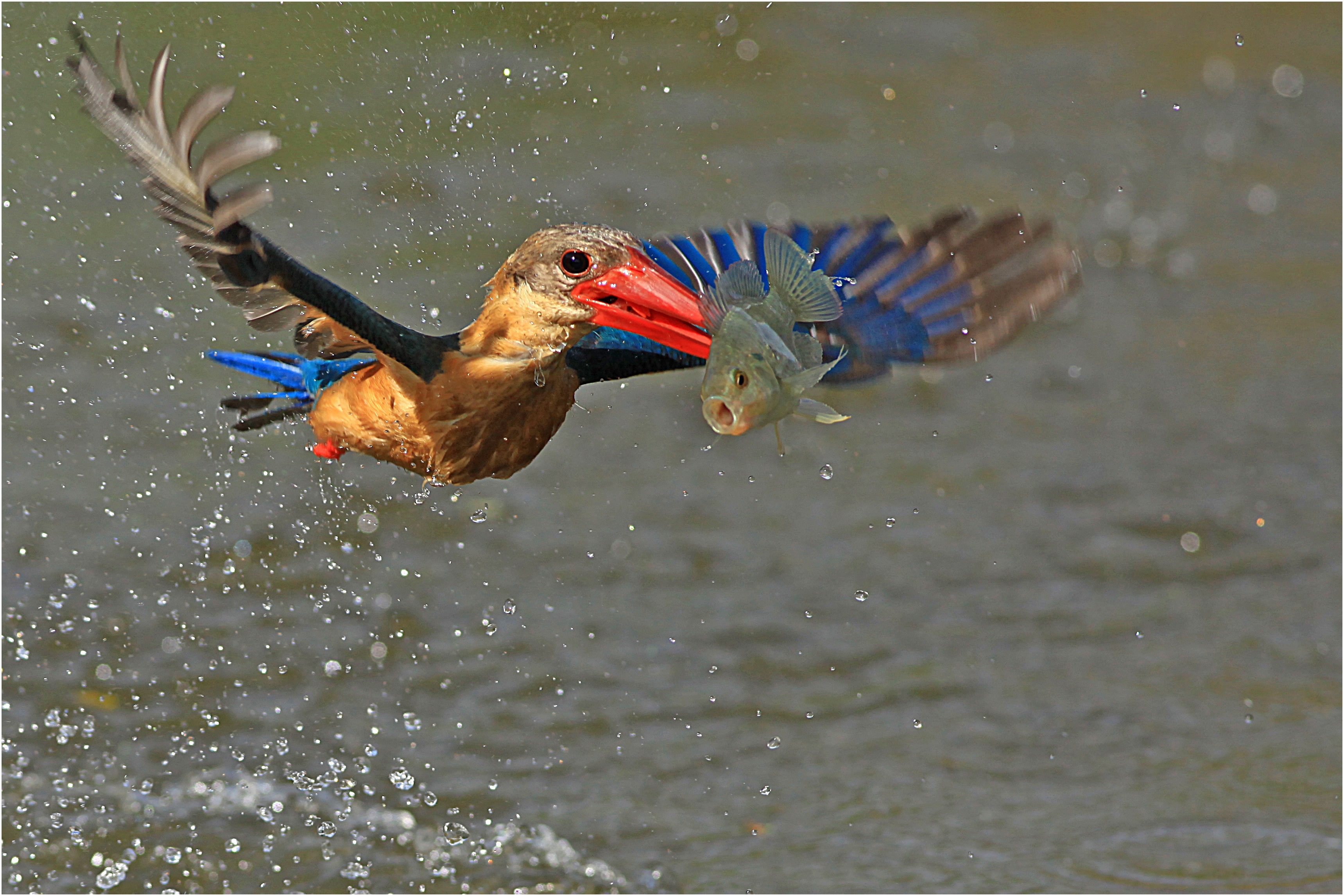
Photo credit: Ong Chwee Sia
|
Scientific name: |
Pelargopsis capensis |
|
Common name: |
Stork-billed Kingfisher |
|
Family: |
Alcedinidae |
What does it look like?
It is the largest kingfisher in Singapore and is easily identified by its large red bill, grey brown head, blue wings and tail, and warm brown collar and underparts.
Ecology, Habitat and Distribution
Diet and Behaviour
Despite its size, it is rather inconspicuous while quietly perched amongst vegetation. Its large build enables it to feed on larger prey such as crabs.
Where are they found?
This species is widespread but uncommon in both freshwater and coastal wetlands across Singapore. A resident pair can often be found perched on the Leopard Tree (Libidibia ferrea) in Japanese Garden.
Raptors
Also known as birds of prey, this group of birds comprises birds like
falcons, eagles, buzzards, kites and owls. They have keen eyesight and
can spot prey from afar, and sharp talons that function as lethal weapons.
They can also tear flesh easily with their curved beaks.
Brahminy Kite

Photo credit: Loke Peng Fai
|
Scientific name: |
Haliastur indus |
|
Common name: |
Brahminy Kite |
|
Family: |
Accipitridae |
What does it look like?
This common, medium-sized raptor is often known as the “Singapore bald eagle”. It is easily identified by the chestnut brown body and white head and breast of the adult. Compared to eagles, kites weigh less, as well as have smaller heads and narrower wings.
Ecology, Habitat and Distribution
Diet and Behaviour
They are primarily scavengers but also prey on a variety of small animals. They are often seen soaring in the air and occasionally diving for food.
Where is it found?
The Brahminy Kite is commonly found in our mangroves, forests, parks and urban areas. It nests in trees in coastal areas. It is widespread in the skies of the Indian subcontinent, Southeast Asia and even Australia.
Brahminy Kites have been known to perch on the Lone Tree in the Grasslands of Jurong Lake Gardens.
Did you know?
The Malaysian island Langkawi, which means reddish brown eagle, was named after this kite.
White-bellied Sea Eagle
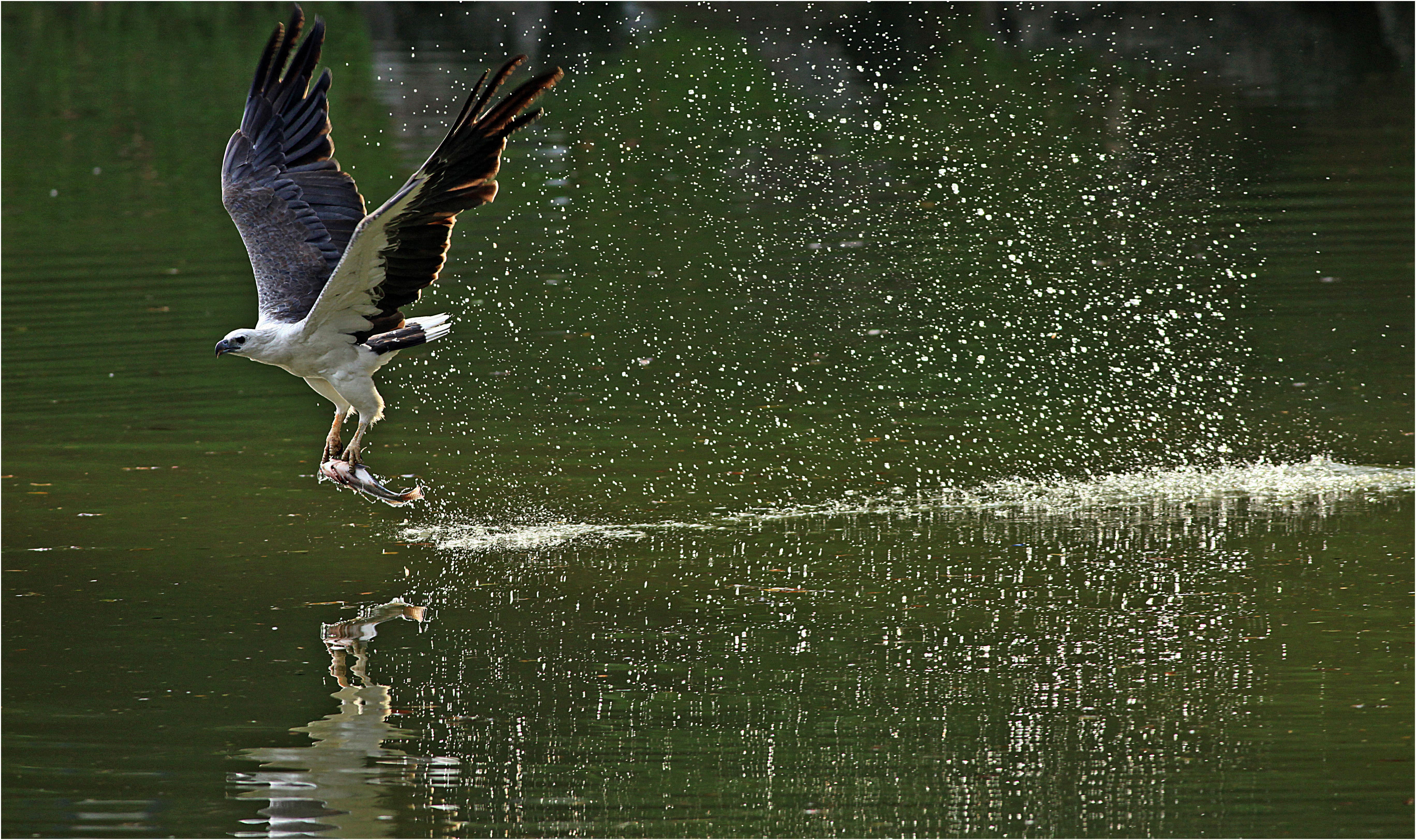
Photo credit: Ong Chwee Sia
|
Scientific name: |
Haliaeetus leucogaster |
|
Common name: |
White-bellied Sea Eagle |
|
Family: |
Accipitridae |
What does it look like?
They are Singapore’s largest resident raptor with an impressive wingspan. These majestic creatures are common and hard to miss while in the air, sporting a wedge-shaped tail with white head and underparts and dark grey upperwings.
Ecology, Habitat and Distribution
Diet and Behaviour
It primarily feeds on fish and sea snakes, which are snatched from the water’s surface with the aid of its large talons. They form monogamous pairs that remain together until one bird dies, after which the remaining bird seeks a new mate. They often perch high in a tree or soar over waterways such as Jurong Lake alone or in pairs.
Where is it found?
You can spot the White-bellied Sea Eagle soaring in coastal areas and over large water bodies like reservoirs. It nests on tall trees such as the Casuarina as well as man-made structures like transmission towers. It has a wide geographic distribution from India and Sri Lanka through Southeast Asia to Australia.
Did you know?
It was featured on the old Singapore $10,000 bird series banknote.
Grey-headed Fish Eagle
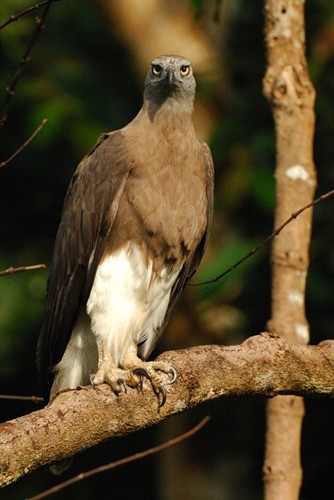
Photo credit: Ong Chwee Sia
|
Scientific name: |
Haliaeetus ichthyaetus |
|
Common name: |
Grey-headed Fish Eagle |
|
Family: |
Accipitridae |
What does it look like?
These rarely encountered eagles are medium-sized, robust and are generally greyish brown with a pale grey head and white tail.
Ecology, Habitat and Distribution
Diet and Behaviour
It primarily eats fish, but also consumes waterbirds and is known to scavenge occasionally. It spends most of their time perched upright on bare branches overlooking water bodies in search of prey.
Where is it found?
It has a wide distribution covering India and Southeast Asia but is generally uncommon. It breeds along the wooded banks of large water bodies and is widespread across Singapore. It has been known to frequent a patch of Casuarina trees opposite Japanese Garden.
Conservation Status
This species is classified as nationally threatened, but its population has increased in recent years.
Crested Serpent Eagle
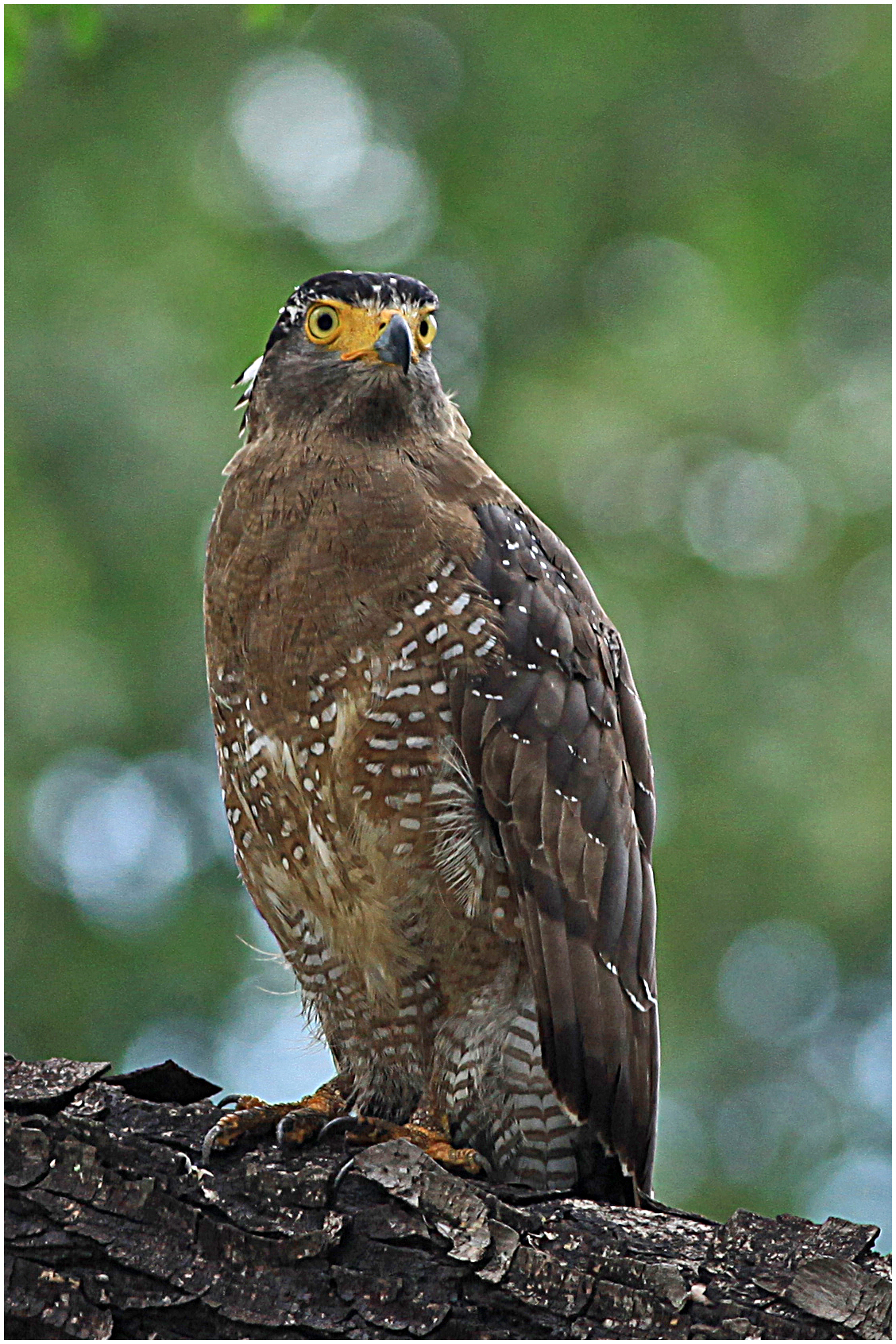
Photo credit: Ong Chwee Sia
|
Scientific name: |
Spilornis cheela |
|
Common name: |
Crested Serpent Eagle |
|
Family: |
Accipitridae |
What does it look like?
The Crested Serpent Eagle has a generally dark brown plumage with a black-and-white crown and yellow beak. Its breast and belly have white barrings and there is a prominent central white band across its tail. In flight, a broad white band on its dark trailing wing feathers is visible from below.
Ecology, Habitat and Distribution
Diet and Behaviour
As its name suggests, it primarily feeds on snakes and is often observed soaring over forested areas in search of prey.
Where are they found?
This species is nationally threatened and is occasionally seen soaring over forested areas or in well-wooded parks. Some of the Crested Serpent Eagles observed in Singapore are migratory and spend the winter months in our green spaces.
Spotted Wood Owl
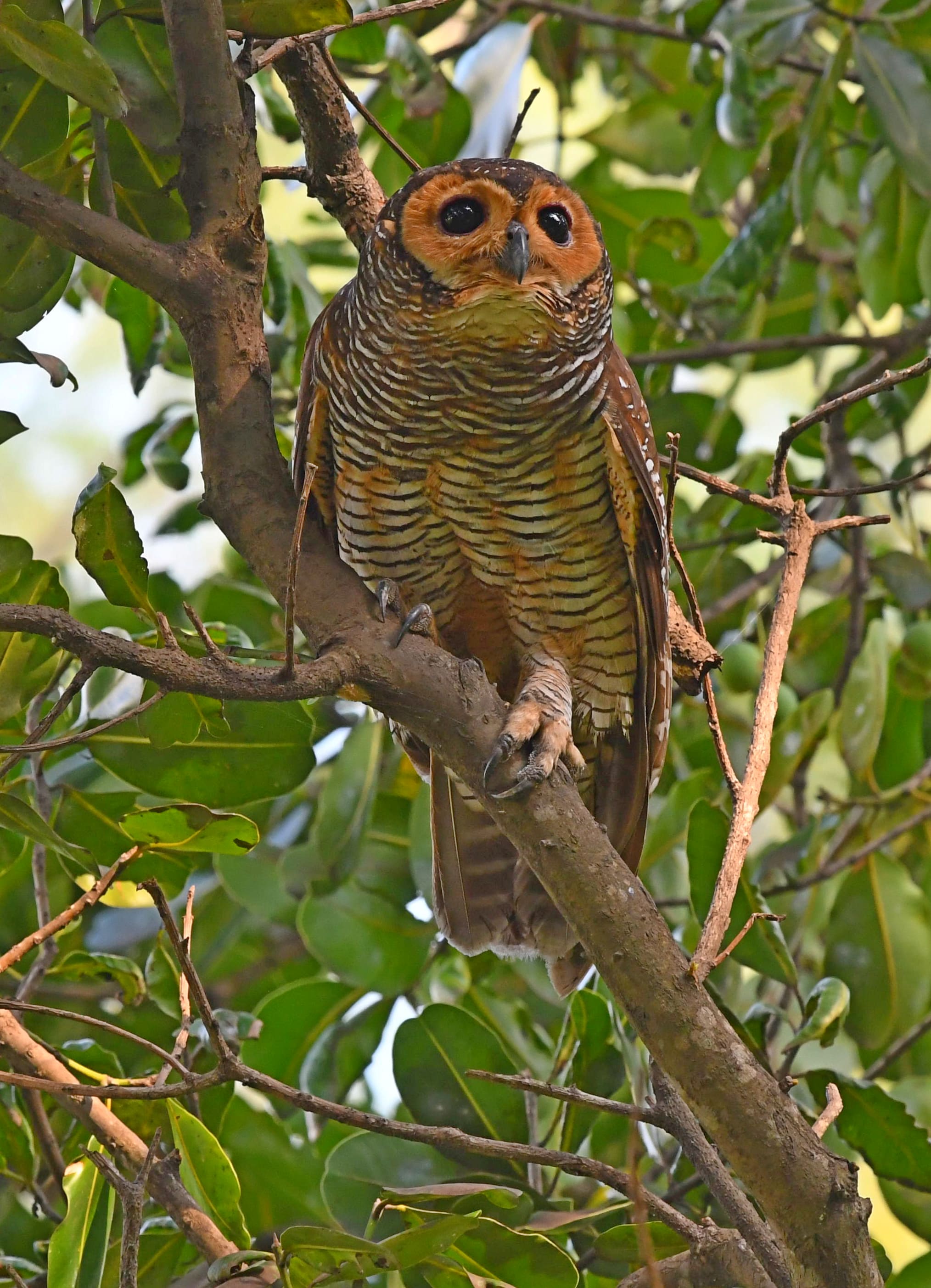
Photo credit: Tan Yip Cheong
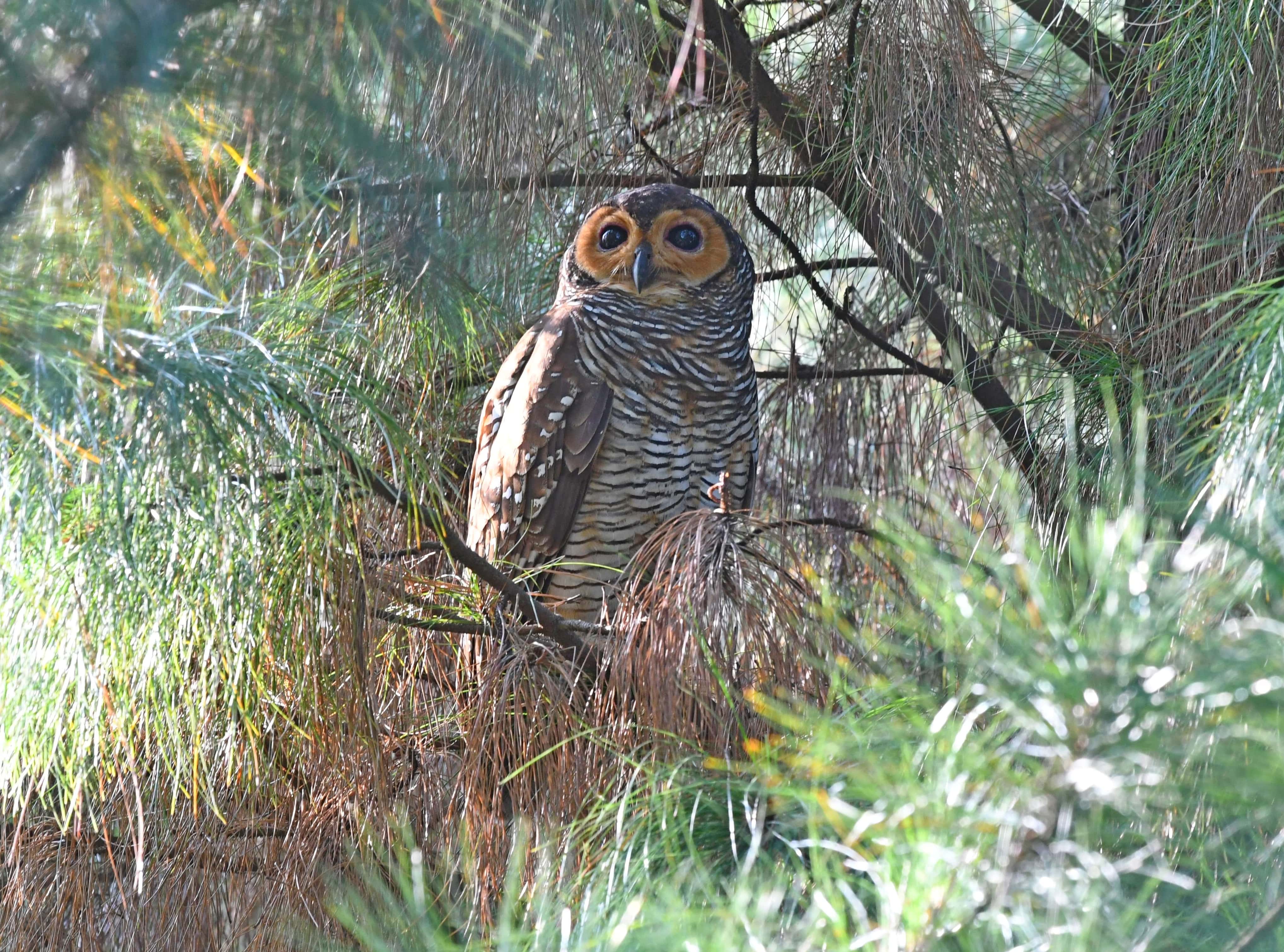
Photo credit: Tan Yip Cheong
|
Scientific name: |
Strix seloputo |
|
Common name: |
Spotted Wood Owl |
|
Family: |
Accipitridae |
What does it look like?
One of the largest owl species in Singapore, you can identify it by its large, earless head and the black bars on its body. It rests on tree branches during the day.
Ecology, Habitat and Distribution
Diet and Behaviour
It hunts small animals like rats, small birds and large insects at night.
Where is it found?
It is usually seen in pairs and is widely distributed across Singapore in a variety of habitats from forests to urban parks. Outside of Singapore, it can also be found across mainland Southeast Asia and the islands of Java and Palawan.
Did you know?
Like other owls, it regurgitates parts of its prey that it cannot swallow, such as skulls and bones, as pellets!
Conservation Status
This is a nationally threatened species. However, its population has increased in recent years.
Buffy Fish Owl
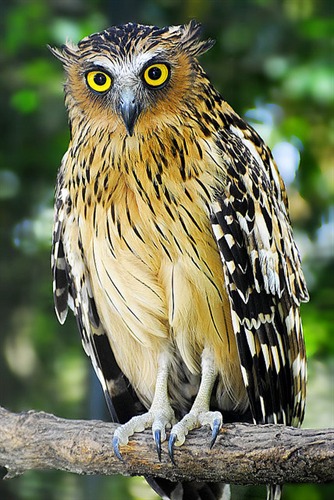
Photo credit: Cai Yixiong, NParks Flora&FaunaWeb
|
Scientific name: |
Ketupa ketupu |
|
Common name: |
Buffy Fish Owl |
|
Family: |
Strigidae |
What does it look like?
The Buffy Fish Owl can be identified from its brown ear tufts, large yellow eyes and black-streaks on its brown underparts.
Ecology, Habitat and Distribution
Diet and Behaviour
At night, the Buffy Fish Owl hunts for prey around water bodies. It mainly feeds on aquatic organisms like frogs and fishes. It usually lays a single egg in epiphytes such as the Bird’s Nest Fern or in tree holes. During the day, it prefers to roost singly in tall dense trees.
Where is it found?
It can be found in wooded areas close to water, including parks, forests and mangroves. Elsewhere, it is found in many other Southeast Asian countries.
Conservation Status
This is a nationally threatened species. However, its population has increased in recent years.
Waterbirds
Waterbirds refer to birds that live on or around water. Many species have specialised adaptations like webbed feet, long legs and serrated bills for life in the wetlands. Waterbirds encompass many bird families including herons and egrets, shorebirds, ducks and rails to name a few. Listed here are some of the more commonly seen waterbirds in Jurong Lake Gardens.
Herons, Bitterns and Egrets
A varied group of birds found in both freshwater and coastal wetlands, they are carnivores that feed on a variety of aquatic prey and small animals. They differ from storks and cranes in their curved “S” shaped necks, which are retracted completely when flying.
Grey Heron
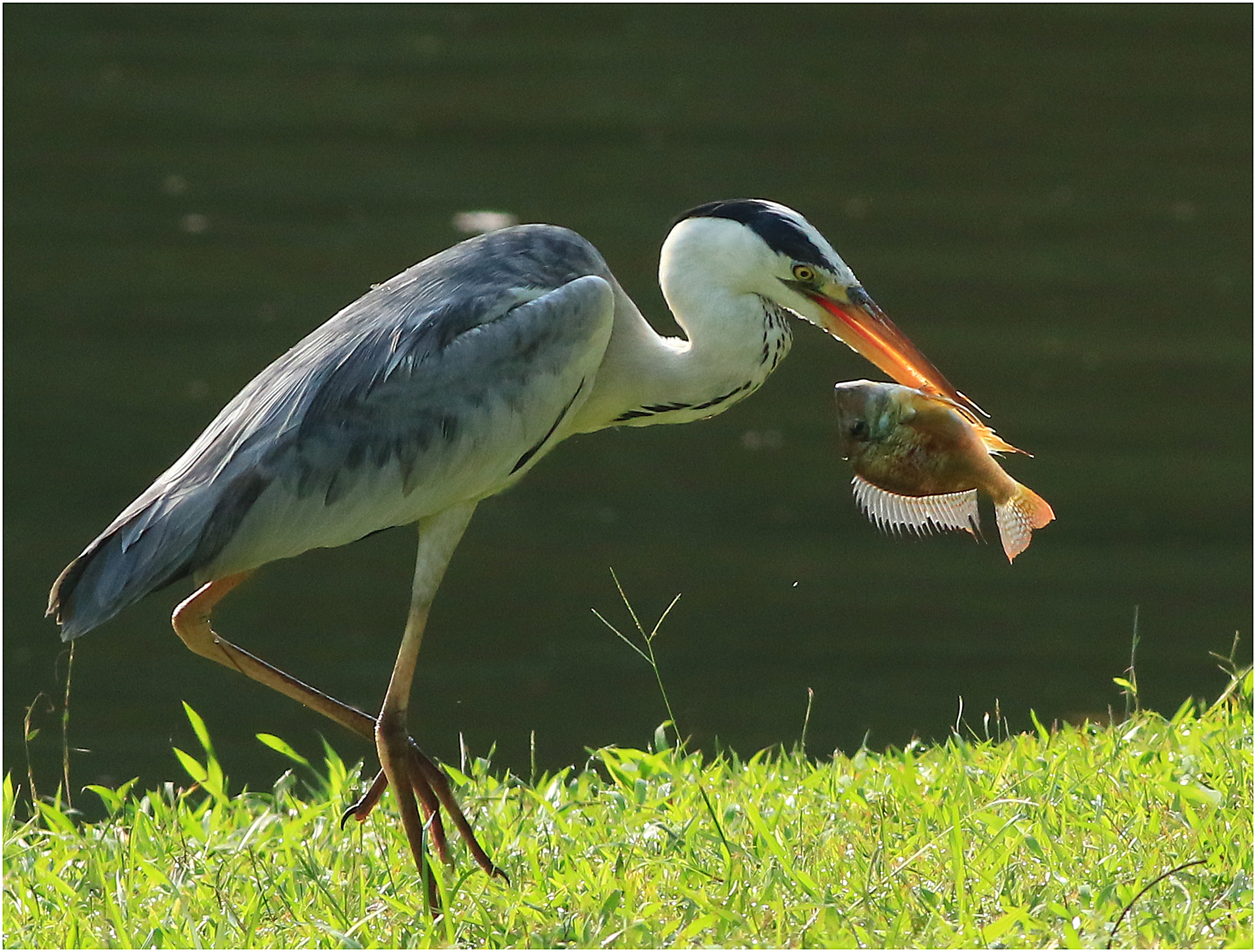
Photo credit: Ong Chwee Sia
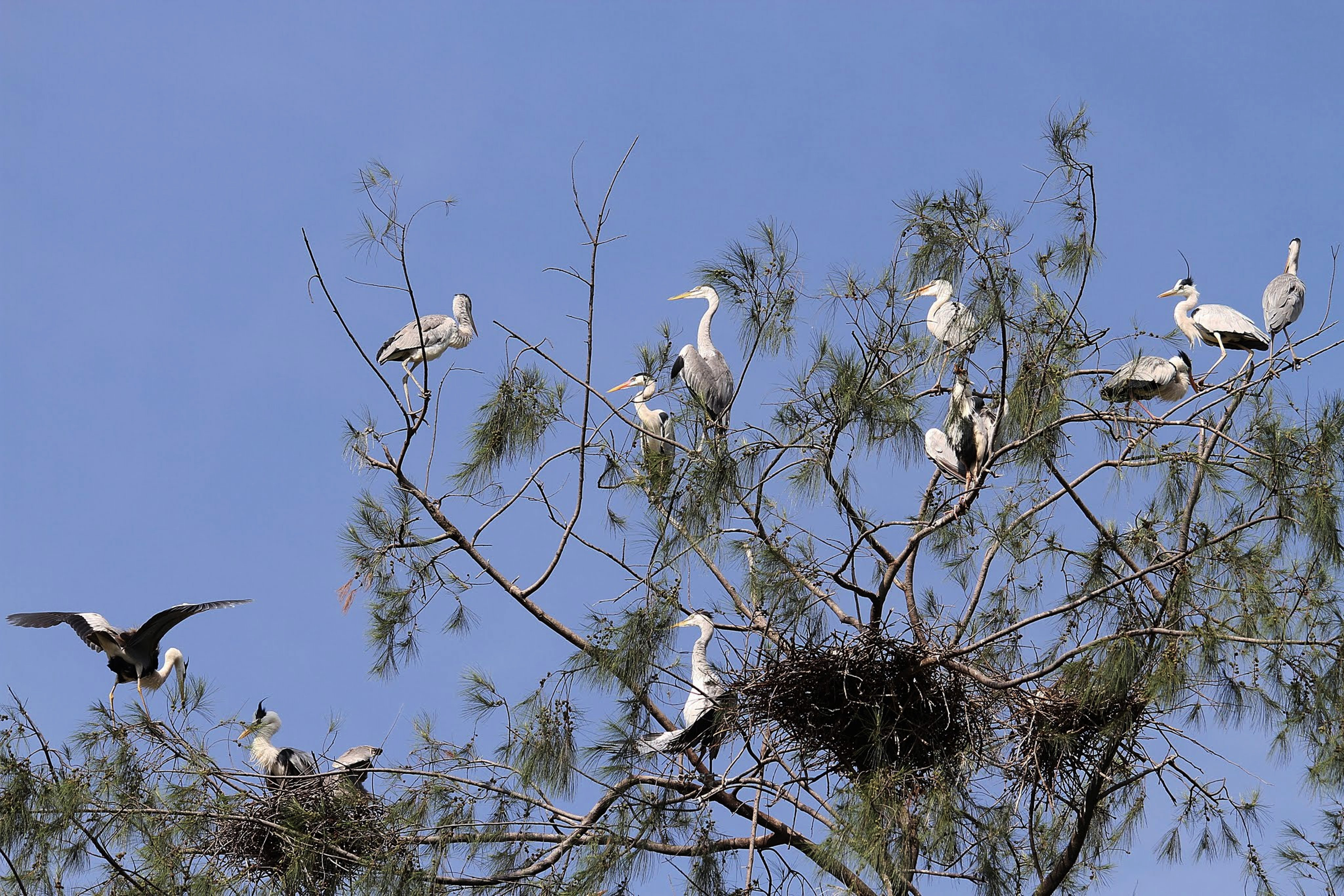
A heronry on a Casuarina Tree at Japanese Garden. Photo credit: Perlyn Chng
|
Scientific name: |
Ardea cinerea |
|
Common name: |
Grey Heron |
|
Family: |
Ardeidae |
What does it look like?
The tallest and most commonly seen heron in Jurong Lake Gardens, the Grey Heron has a wingspan of 2 m. It has mostly white plumage with a black stripe on the head and black streaks down the centre of its neck. Its bill is dull yellow. You can observe a nesting colony on the Casuarina trees at Japanese Garden.
Ecology, Habitat and Distribution
Diet and Behaviour
They feed on fish, amphibians, small mammals and insects. They are often observed perched on trees or the banks of large water bodies.
Where are they found?
This species is commonly observed in a variety of freshwater and coastal wetlands across Singapore. Nesting colonies can be found at Pasir Ris Park and Japanese Garden. They are widely distributed globally and can be found in Europe, Africa and Asia.
Did you know?
A nesting colony of herons is known as a heronry.
Conservation Status
It is classified as nationally endangered, but the local population has been increasing in recent years.
Purple Heron
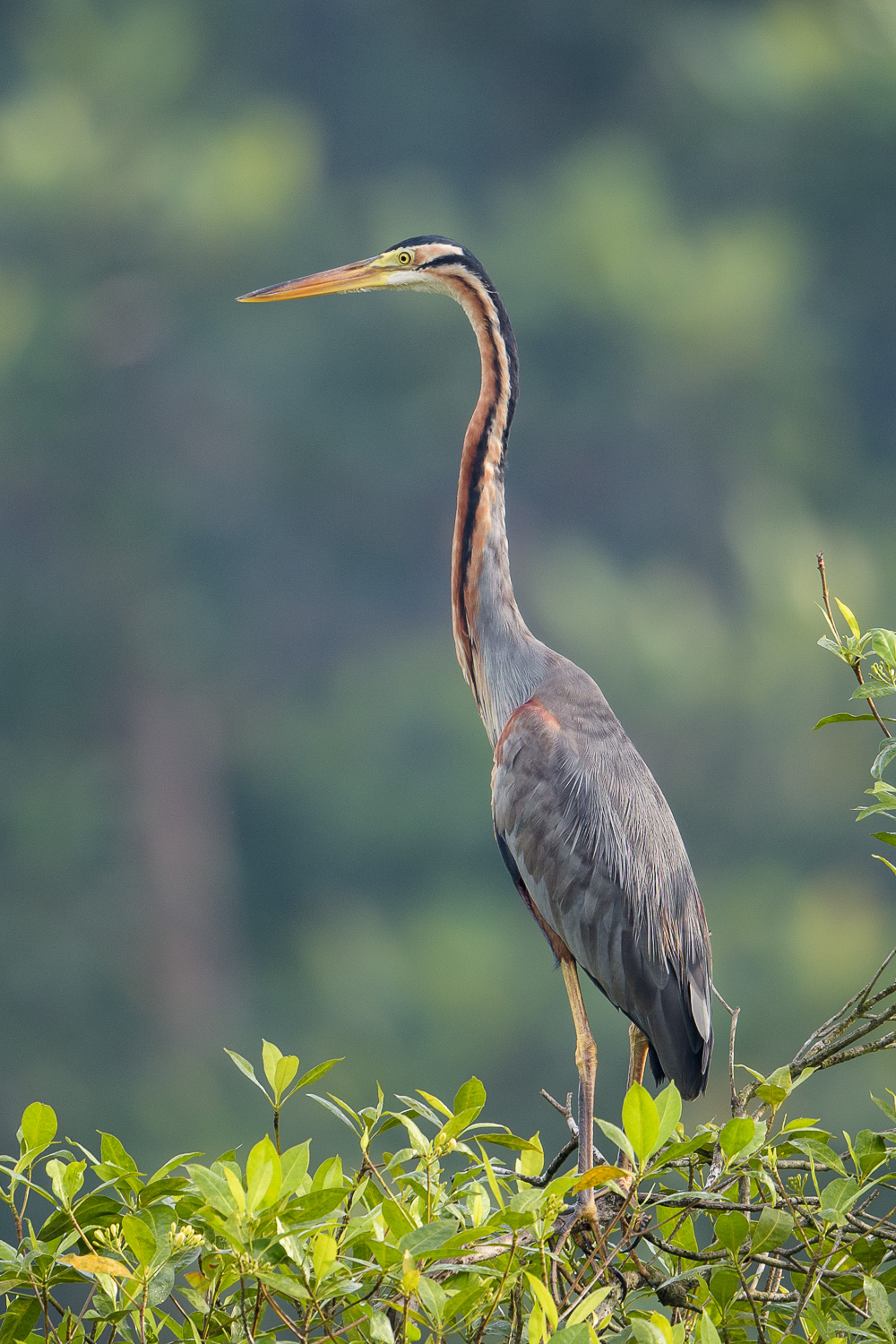
Photo credit: Francis Yap
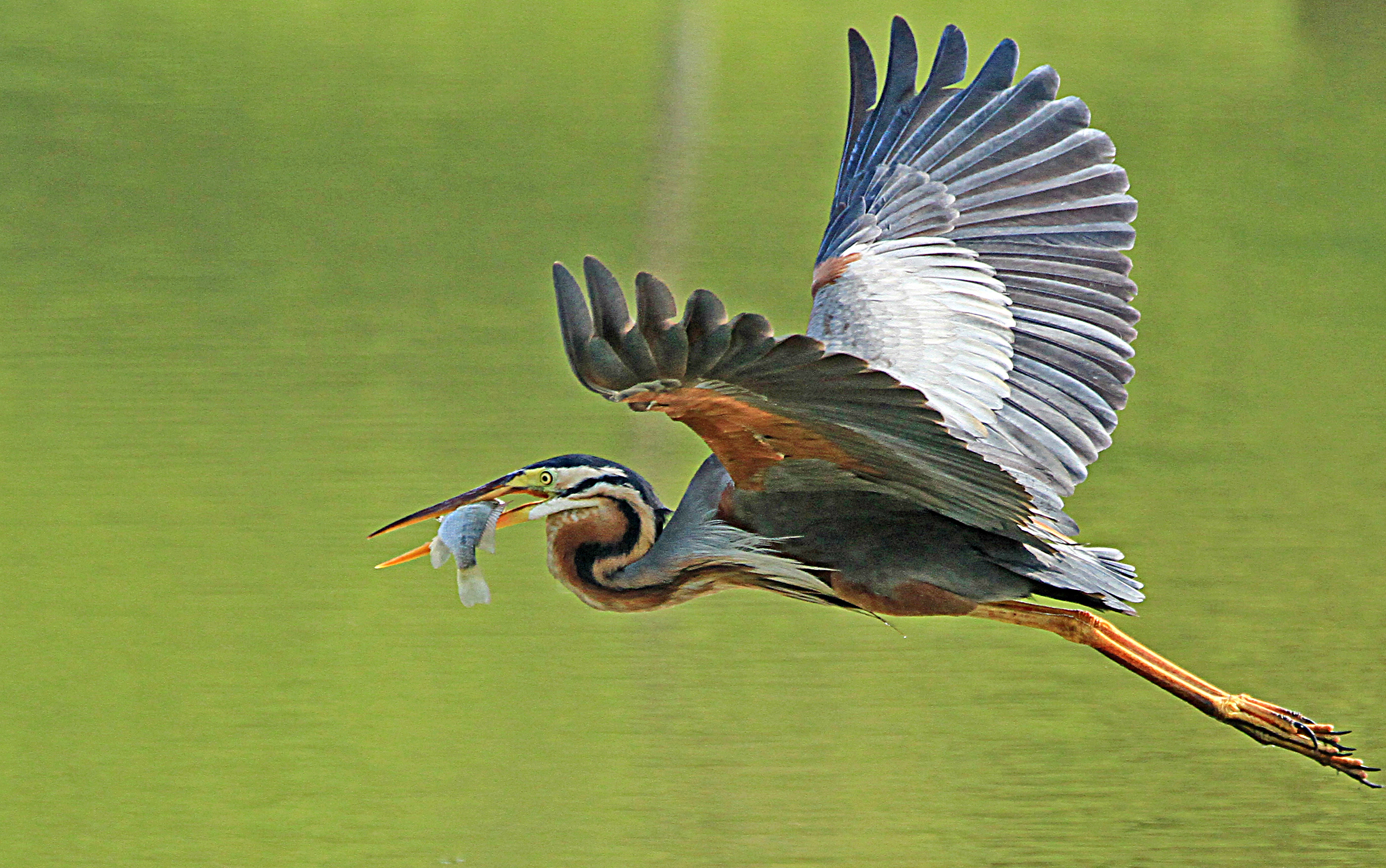
Photo credit: Ong Chwee Sia
|
Scientific name: |
Ardea pupurea |
|
Common name: |
Purple Heron |
|
Family: |
Ardeidae |
What does it look like?
The adult Purple Heron has a black crown with distinct black lines running down the sides of its face and neck. It has grey upperparts, a reddish-brown neck, and dark chestnut underparts. The bill and legs are yellowish orange. The juvenile is largely brown and lacks the bold black lines along its head and neck.
Ecology, Habitat and Distribution
Diet and Behaviour
The Purple Heron feeds on a wide variety of prey including fish, frogs and other small animals. Like many herons, it stands motionless in shallow water, waiting for the opportunity to impale its prey with its sharp beak. It is shy and often conceals itself in dense vegetation.
Where are they found?
It is an uncommon resident that is usually observed in well-vegetated freshwater wetlands in Singapore including Kranji Marshes, Bishan-Ang Mo Kio Park and Jurong Lake Gardens. The Purple Heron is also found from Africa and Europe to the Indian subcontinent and Southeast Asia.
Striated Heron
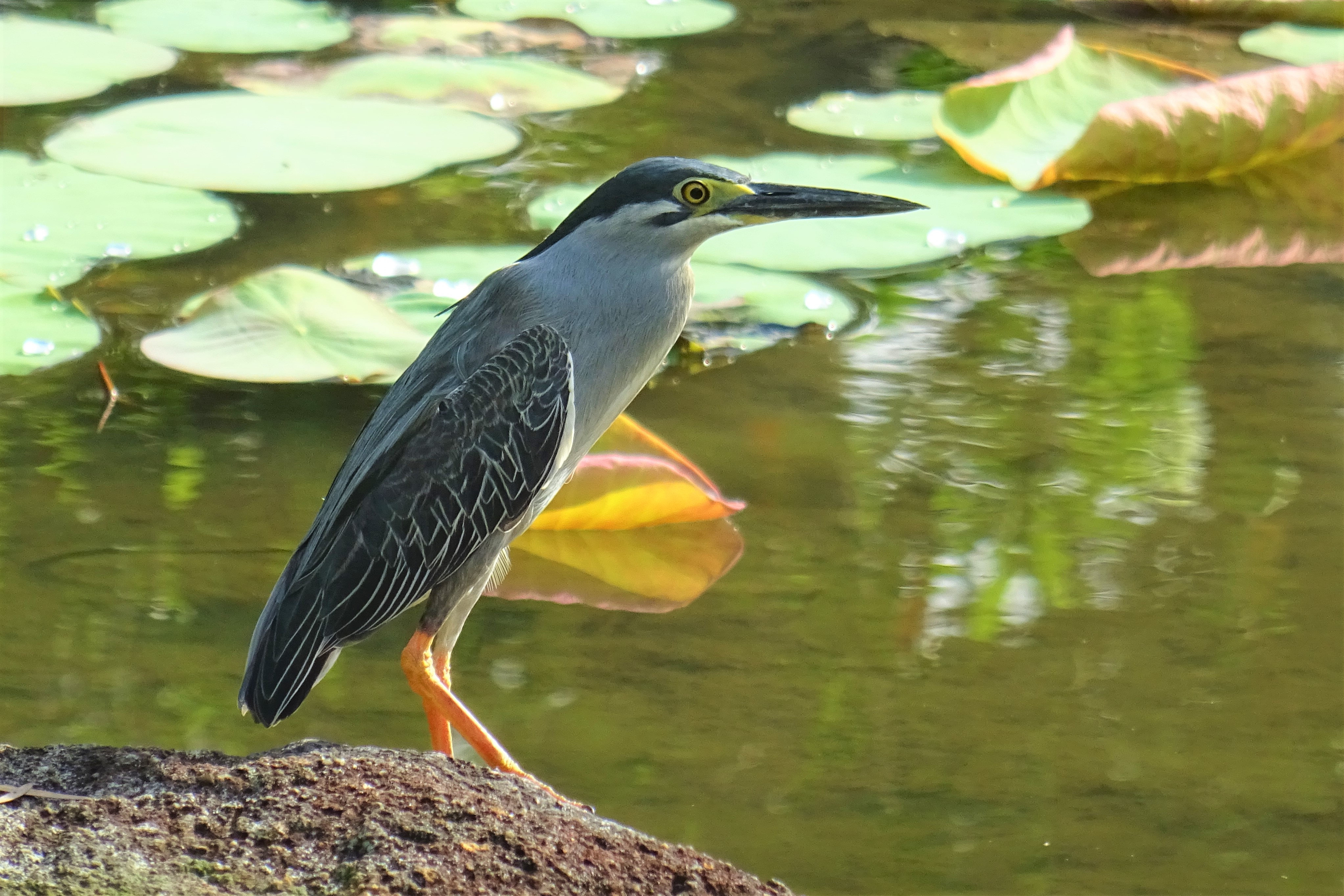
Photo credit: Ruth Tan (NParks)
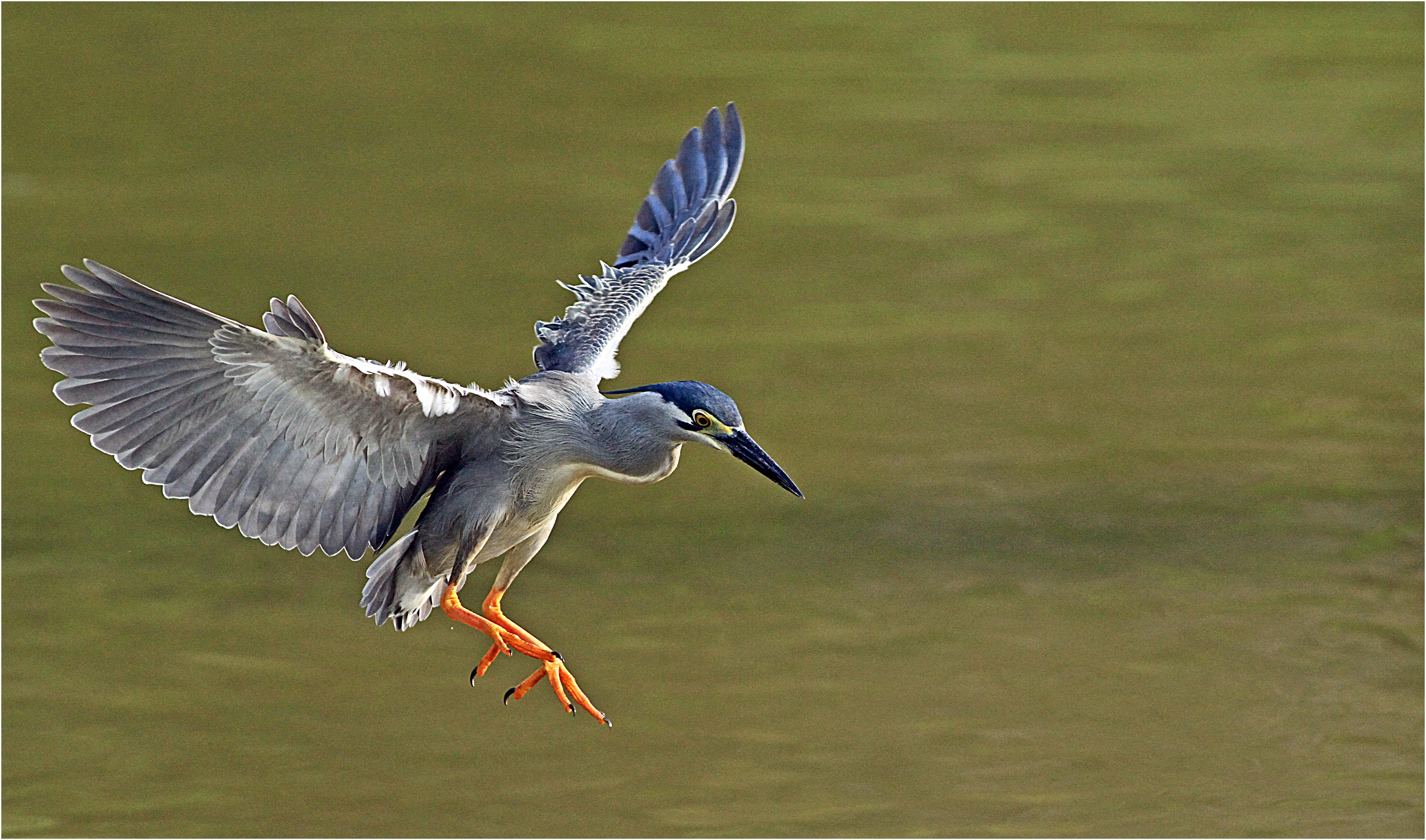
In flight. Photo credit: Ong Chwee Sia
|
Scientific name: |
Butorides striata |
|
Common name: |
Striated Heron |
|
Family: |
Ardeidae |
What does it look like?
The Striated Heron has bluish grey plumage with a black cap on its head and a dark bill. Its wings are black with buff edges, giving it the appearance of white scales. Its legs are glossy orange during breeding season, but olive grey or yellowish green otherwise. Compared to the Grey Heron it is smaller and stockier.
Ecology, Habitat and Distribution
Diet and Behaviour
Like most herons, aquatic prey like fish form a large part of their diet. They are solitary and are often seen perching along the banks of water bodies.
Where are they found?
This is the most adaptable and commonly encountered small heron in Singapore. They can be found in all freshwater and coastal wetlands, including urban canals.
Did you know?
Striated Herons are known to use pieces of bread as bait when hunting fish.
Black-crowned Night Heron

Photo credit: Francis Yap
|
Scientific name: |
Nycticorax nycticorax |
|
Common name: |
Black-crowned Night Heron |
|
Family: |
Ardeidae |
What does it look like?
Both adults and juveniles have distinctive red eyes. Adults have a diagnostic black crown, bill and back which contrast with their white underparts. Juveniles have dull grey plumage with pale spots.
Ecology, Habitat and Distribution
Diet and Behaviour
These birds are primarily nocturnal. Their diet includes small fish, crustaceans, frogs and large insects. During the day, they rest in dense trees close to water.
Where are they found?
These shy birds are found in larger freshwater and coastal wetlands across Singapore. Globally, they have a wide distribution ranging from Europe and Africa to most of Southeast Asia.
Did you know?
Its scientific name Nycticorax means “night raven” in Latin and
reflects the heron’s nocturnal habits and distinctive call.
Conservation Status
This species is nationally threatened due to the lack of suitable nesting habitat.
Chinese Pond Heron
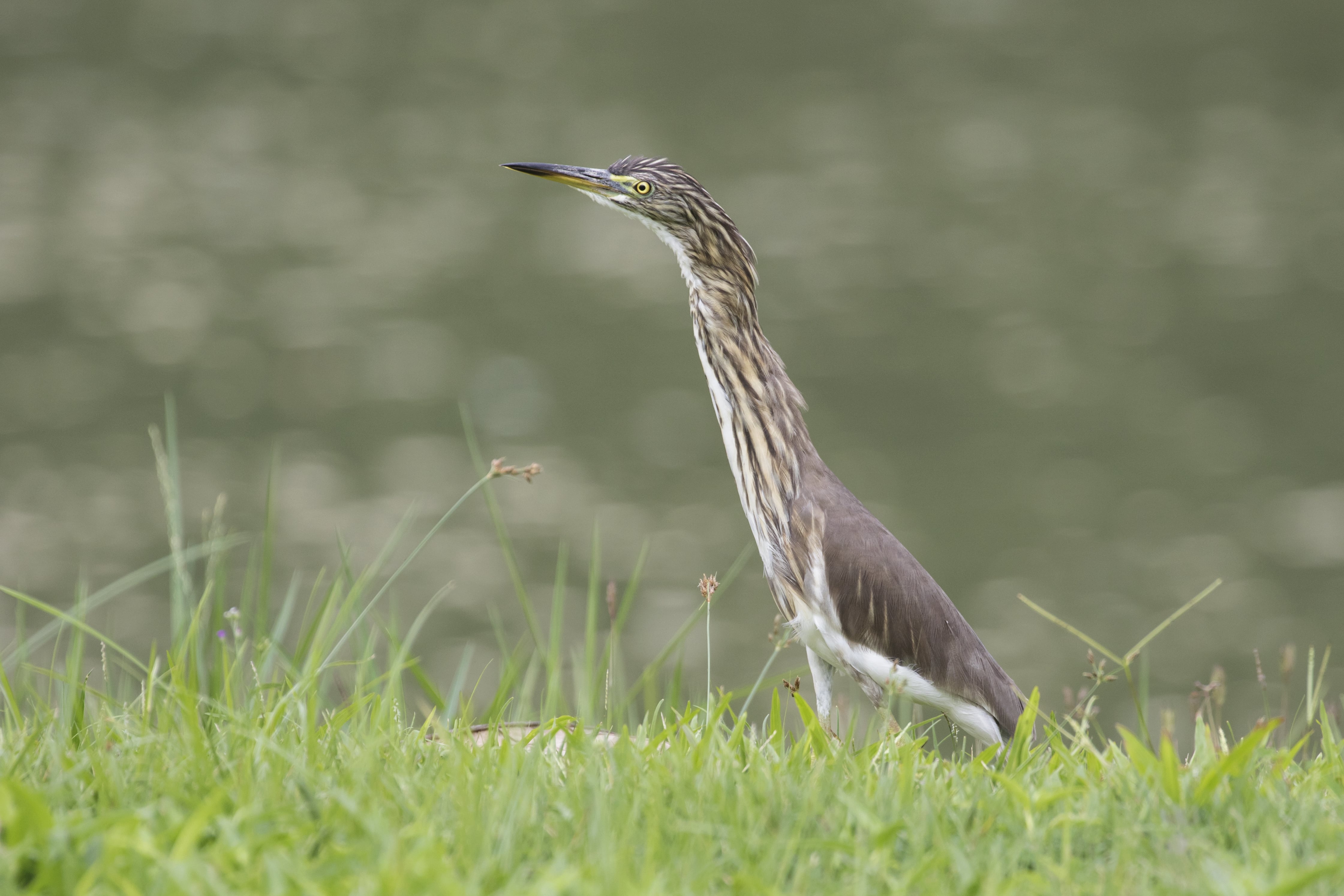
Non-breeding plumage. Photo credit: Loke Peng Fai

Breeding plumage. Photo credit: Francis Yap
|
Scientific name: |
Ardeola bacchus |
|
Common name: |
Chinese Pond Heron |
|
Family: |
Ardeidae |
What does it look like?
It is indistinguishable from other pond herons like the Javan Pond Heron and Indian Pond Heron during non-breeding season. However, its breeding plumage is distinctive with a maroon head, neck and upper breast, white underparts and a black back.
Ecology, Habitat and Distribution
Diet and Behaviour
They are usually observed in flooded fields and freshwater marshes where they forage on a variety of small animals.
Where are they found?
This is a migratory species which breeds in China and migrates to Southeast
Asia during the northern winter. They are usually found in freshwater wetlands
and flooded fields such as Bishan-Ang Mo Kio Park and Lorong Halus. They
are frequently observed in the field between Chinese Garden MRT station
and Jurong Lake Gardens.
Yellow Bittern
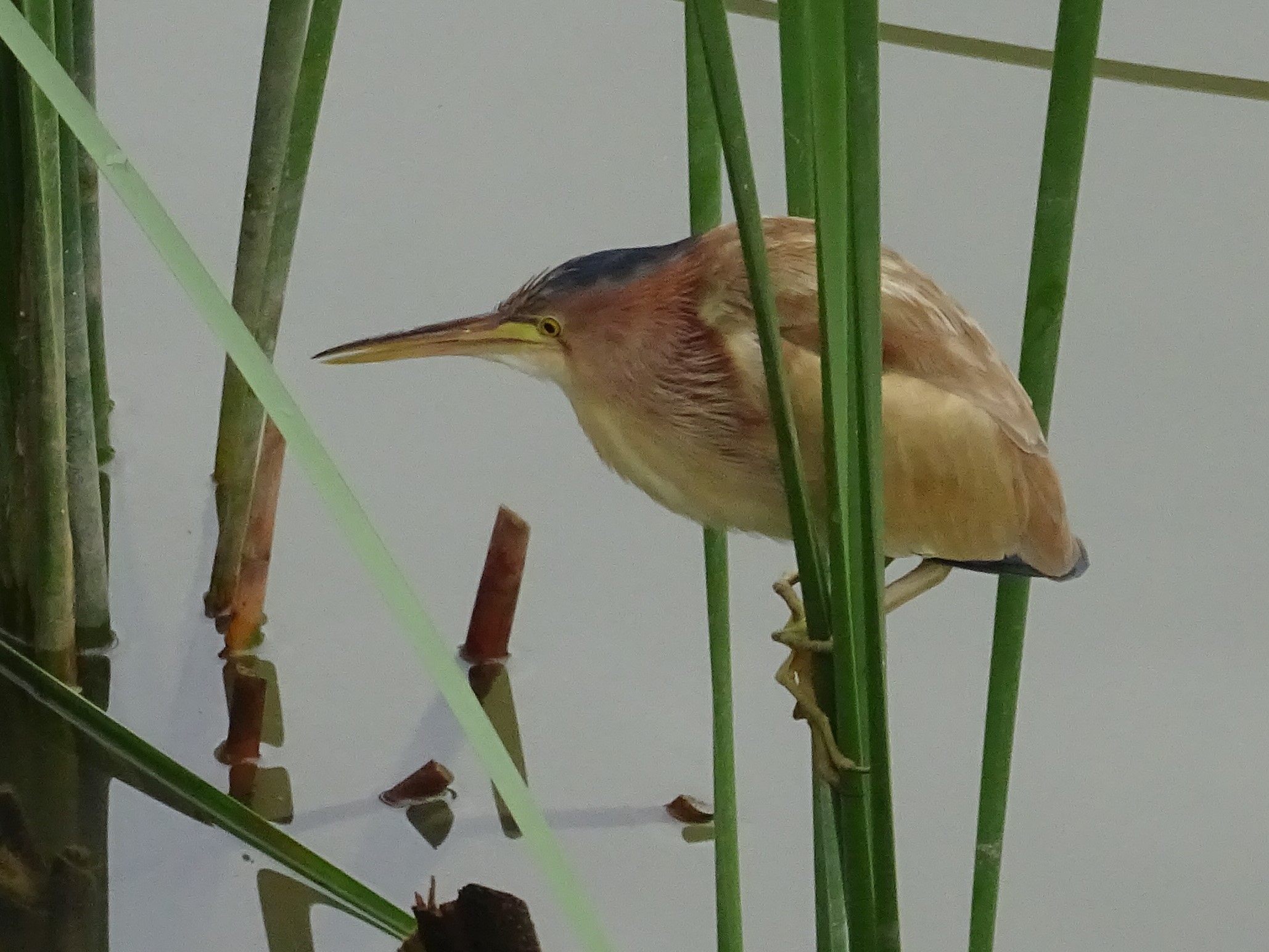
Male. Photo credit: Woo Mun Shih
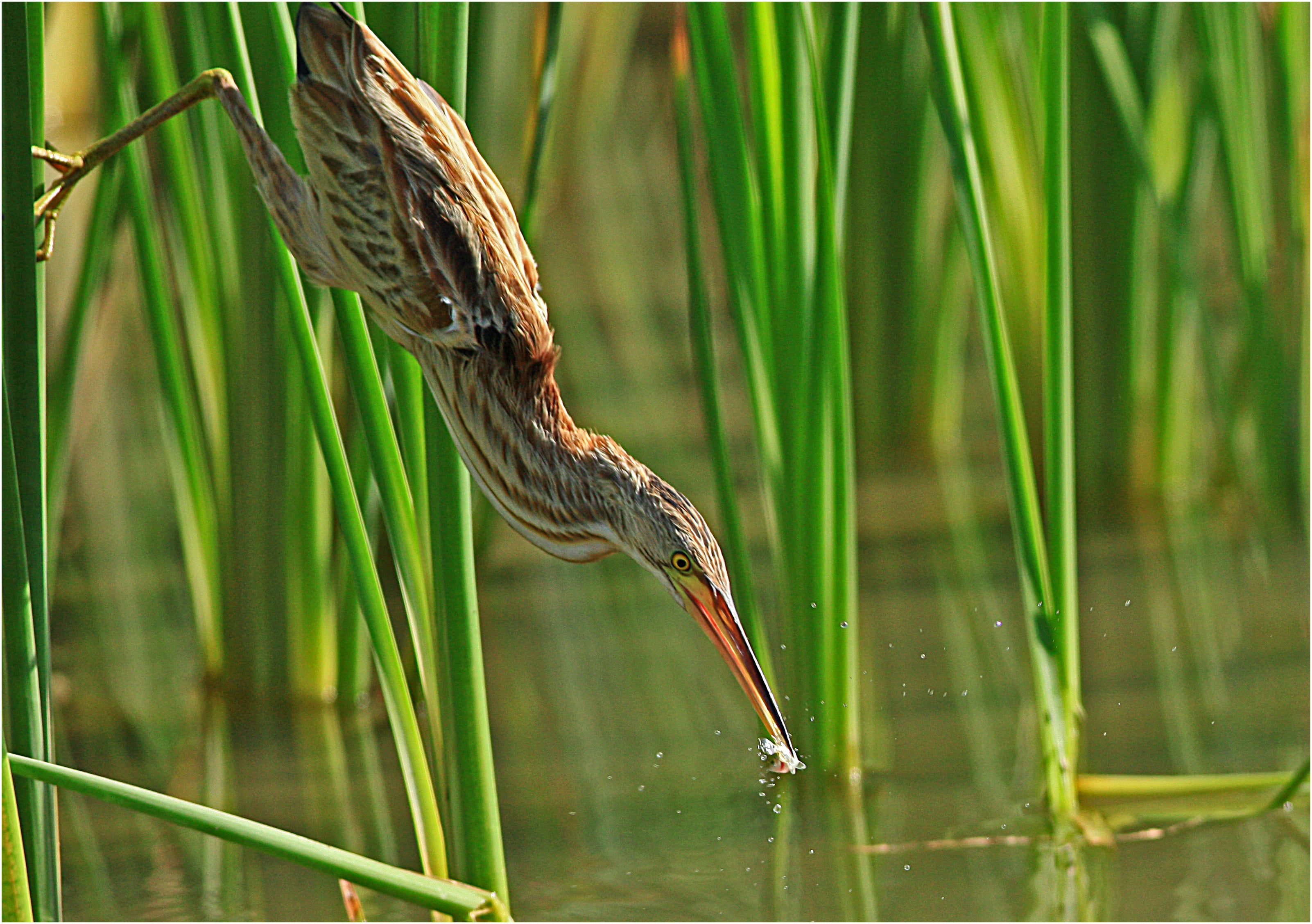
Female. Photo credit: Ong Chwee Sia
|
Scientific name: |
Ixobrychus sinensis |
|
Common name: |
Yellow Bittern |
|
Family: |
Ardeidae |
What does it look like?
This species exhibits sexual dimorphism, meaning the males and females look different. Males have a black crown, while the females are brown throughout. The striking contrast between their black flight feathers and yellowish plumage makes them easy to identify in flight.
Ecology, Habitat and Distribution
Diet and Behaviour
It is often seen perched motionless in reed beds waiting to ambush passing prey. They feed on fish, insects and crustaceans.
Where are they found?
It is found in freshwater wetlands including marshes and well-vegetated ponds. It is regularly seen at Gardens by the Bay, Kranji Marshes and Jurong Lake Gardens, among other sites.
Did you know?
Every year between October to March, Singapore’s resident Yellow Bittern population is joined by migratory populations that breed in China and migrate to Southeast Asia to escape the northern winter.
Eastern Cattle Egret
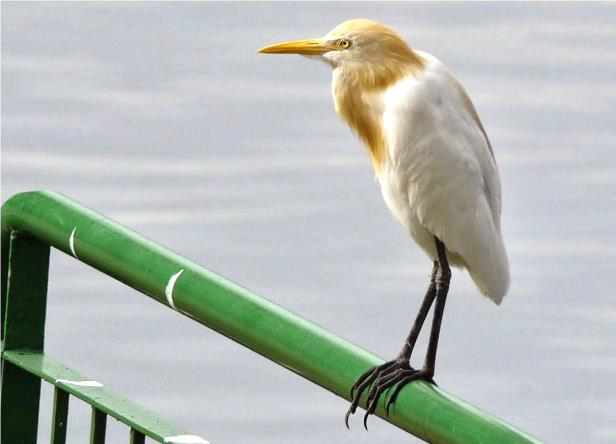
Photo credit: Perlyn Chng
|
Scientific name: |
Bubulcus coromandus |
|
Common name: |
Eastern Cattle Egret |
|
Family: |
Ardeidae |
What does it look like?
While it looks similar to other white egret species, it tends to be smaller, stockier and sports a shorter and thicker neck, with a short yellowish bill and black legs. During breeding season, they develop golden brown plumes.
Ecology, Habitat and Distribution
Diet and Behaviour
As their name suggests, they are usually found in flooded fields in close proximity to livestock. They forage on small animals flushed out by moving livestock and also feed on parasites found on the livestock.
Where are they found?
They are found across much of the world’s tropical regions. In Singapore, it is a migratory species and flocks are regularly seen in flooded fields during the northern winter.
Did you know?
In Singapore, Eastern Cattle Egrets have adapted to feasting on small
animals disturbed by grass cutters and lawnmowers!
Little Egret
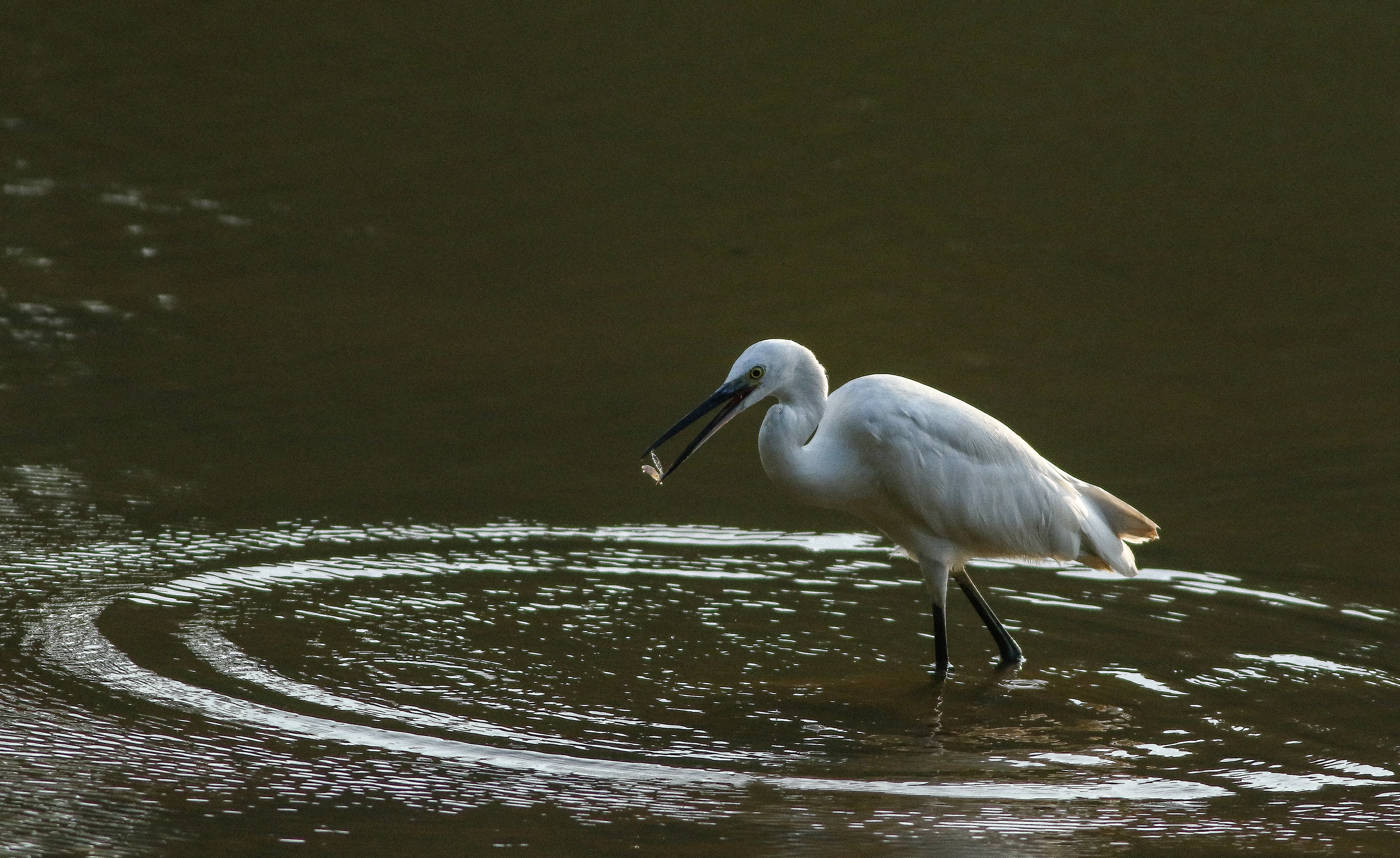
Photo credit: Ong Chwee Sia
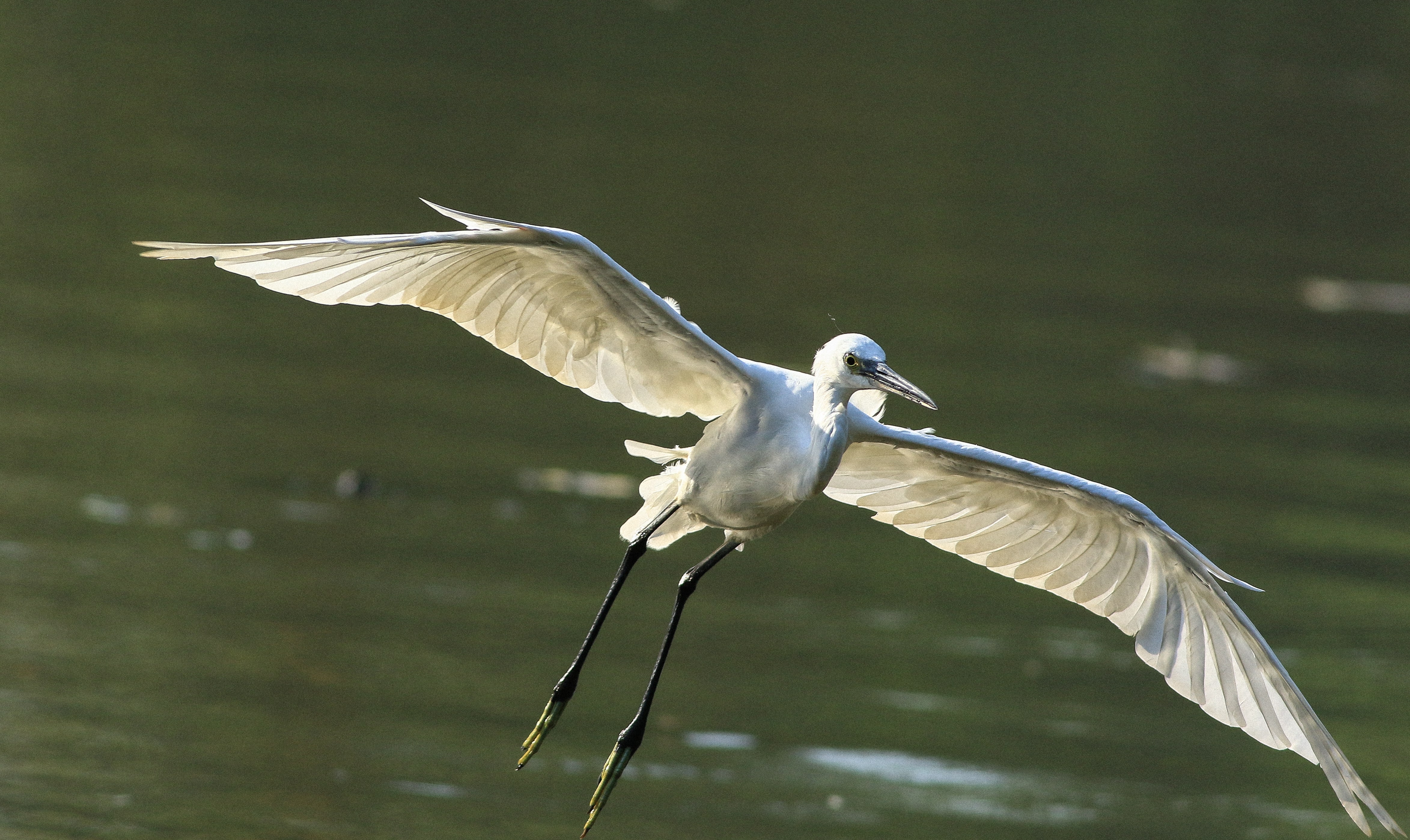
Photo credit: Ong Chwee Sia
|
Scientific name: |
Egretta garzetta |
|
Common name: |
Little Egret |
|
Family: |
Ardeidae |
What does it look like?
The Little Egret has a uniformly white plumage with black legs, green toes, and a blackish beak. During the breeding season, the adult develops white plumes behind its head.
Ecology, Habitat and Distribution
Diet and Behaviour
The Little Egret is gregarious and is often found in flocks. It employs a variety of methods to catch fish for food, such as disturbing small fish by shuffling its feet in water or using a wait-and-ambush strategy.
Where are they found?
It is a common migrant in Singapore, and can be observed in a variety
of wetlands from urban canals to coastal mudflats. It breeds in countries
such as China, Korea and Japan.
Rails
Rails are a large family of ground-dwelling birds associated with wetlands. Most species are shy and prefer to run at the first sign of danger. Even so, many species undertake long distance migrations from their breeding grounds in northern Asia to spend winter in Southeast Asia’s wetlands.
White-breasted Waterhen

Photo credit: Francis Yap
|
Scientific name: |
Amaurornis phoenicurus |
|
Common name: |
White-breasted Waterhen |
|
Family: |
Rallidae |
What does it look like?
It is easily identified by its contrasting black upperparts and white underparts with a chocolate brown vent.
Ecology, Habitat and Distribution
Diet and Behaviour
These omnivorous birds are often observed foraging at the edge of freshwater wetlands close to dense vegetation. When threatened, they make a dash for the nearest cover.
Where are they found?
This bird is commonly encountered in wetlands across Singapore and has adapted to life in urban ponds as well. It is distributed across the Indian Subcontinent and Southeast Asia.
Did you know?
Their chicks are flightless and have a uniformly black body!
Shorebirds
Common Sandpiper

Photo credit: Nicholas Kee (NParks)
|
Scientific name: |
Actitis hypoleucos |
|
Common name: |
Common Sandpiper |
|
Family: |
Scolopacidae |
What does it look like?
The Common Sandpiper has grey-brown upperparts, white underparts, and yellowish-brown legs.
Ecology, Habitat and Distribution
Diet and Behaviour
The Common Sandpiper is solitary and has a habit of bobbing its head up and down while walking, and flicking its wings in flight. It is often observed feeding on small invertebrates along the banks of canals and artificial water bodies like reservoirs.
Where are they found?
It is the most commonly encountered shorebird in Singapore and can be observed in both freshwater and coastal wetlands. It breeds across many European countries such as Russia.
Woodpeckers and Barbets
Asian Barbets
Asian barbets are from the family Megalaimidae. They have large heads relative to their body and are generally brightly coloured, arboreal (tree-dwelling) birds. The name ‘barbet’ comes from the bristles around their beak. They nest in tree holes excavated using their powerful beaks, and feed primarily on fruits. There are three species found in Singapore and one of them can be found in Jurong Lake Gardens.
Coppersmith Barbet
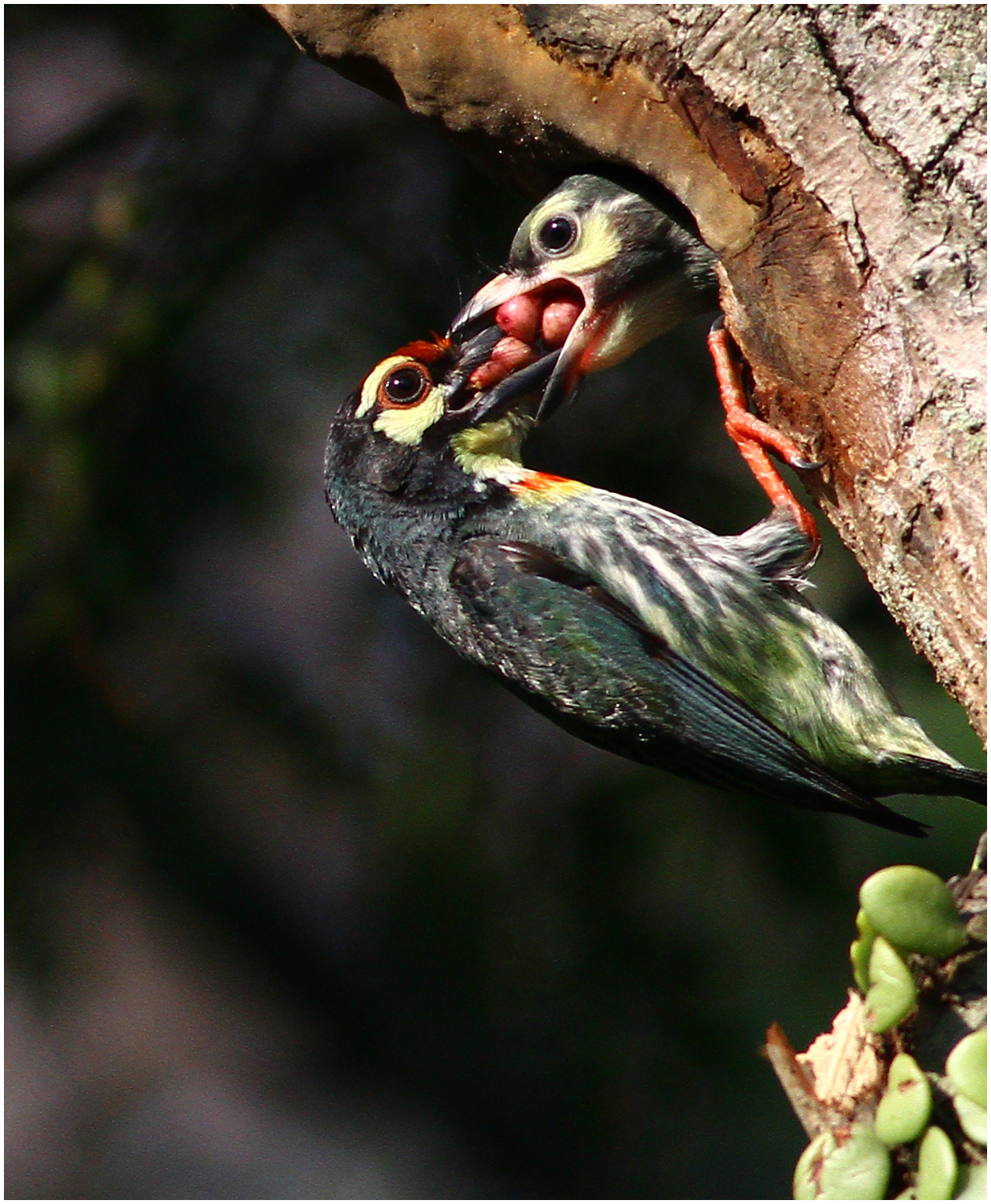
Photo credit: Ong Chwee Sia
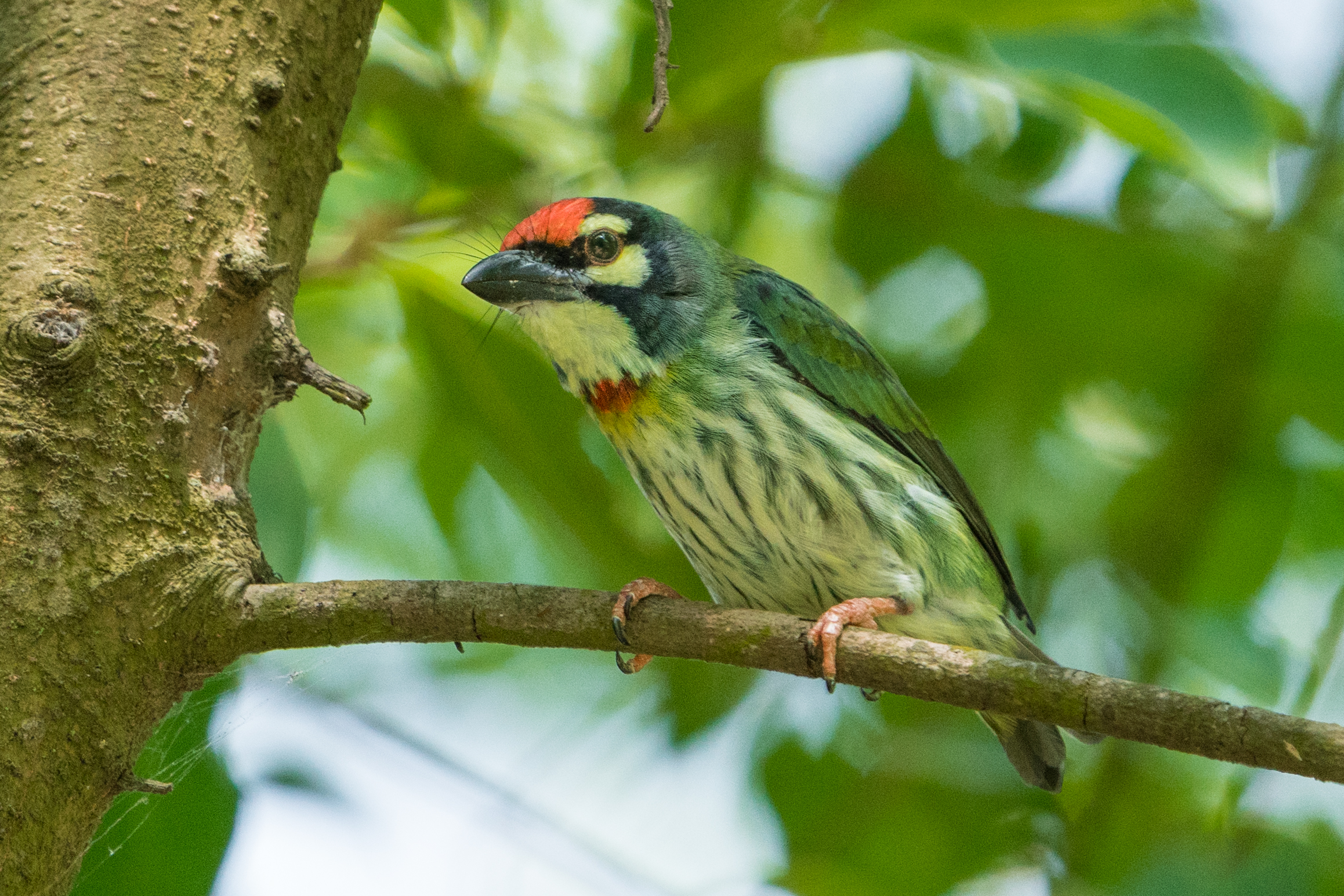
Photo credit: Tan Chuan-Yean
|
Scientific name: |
Megalaima haemacephala |
|
Common name: |
Coppersmith Barbet |
|
Family: |
Megalaimidae |
What does it look like?
Its name is derived from its call which sounds like a coppersmith hitting
copper sheets – a continuous ‘tonk tonk tonk’ sound. Adults
have greenish upperparts, a stout blackish bill with fine bristles, a crimson
forehead, and yellow underparts, around the eyes and on the throat.
Ecology, Habitat and Distribution
Diet and Behaviour
They are often encountered alone or in pairs. They feed primarily on fruits but will consume insects and small animals as well, particularly during breeding season. They breed from February to July and nest in tree cavities.
Where are they found?
This species is the barbet that has adapted most to urban environments and is frequently observed in urban green spaces. Elsewhere, it occurs on the Indian subcontinent, China and Southeast Asia.
Woodpeckers
Woodpeckers are from the family Picidae, a large family consisting of over 200 species worldwide. They are characterised by their unique feeding behaviour, which involves drilling into trees in search of insects, which they pull out with their long, sticky tongues. Their skulls have special adaptations to protect their brains from the force generated while drilling for food. There are eight species of woodpeckers recorded in Singapore, four of which can be found in Jurong Lake Gardens.
Common Flameback
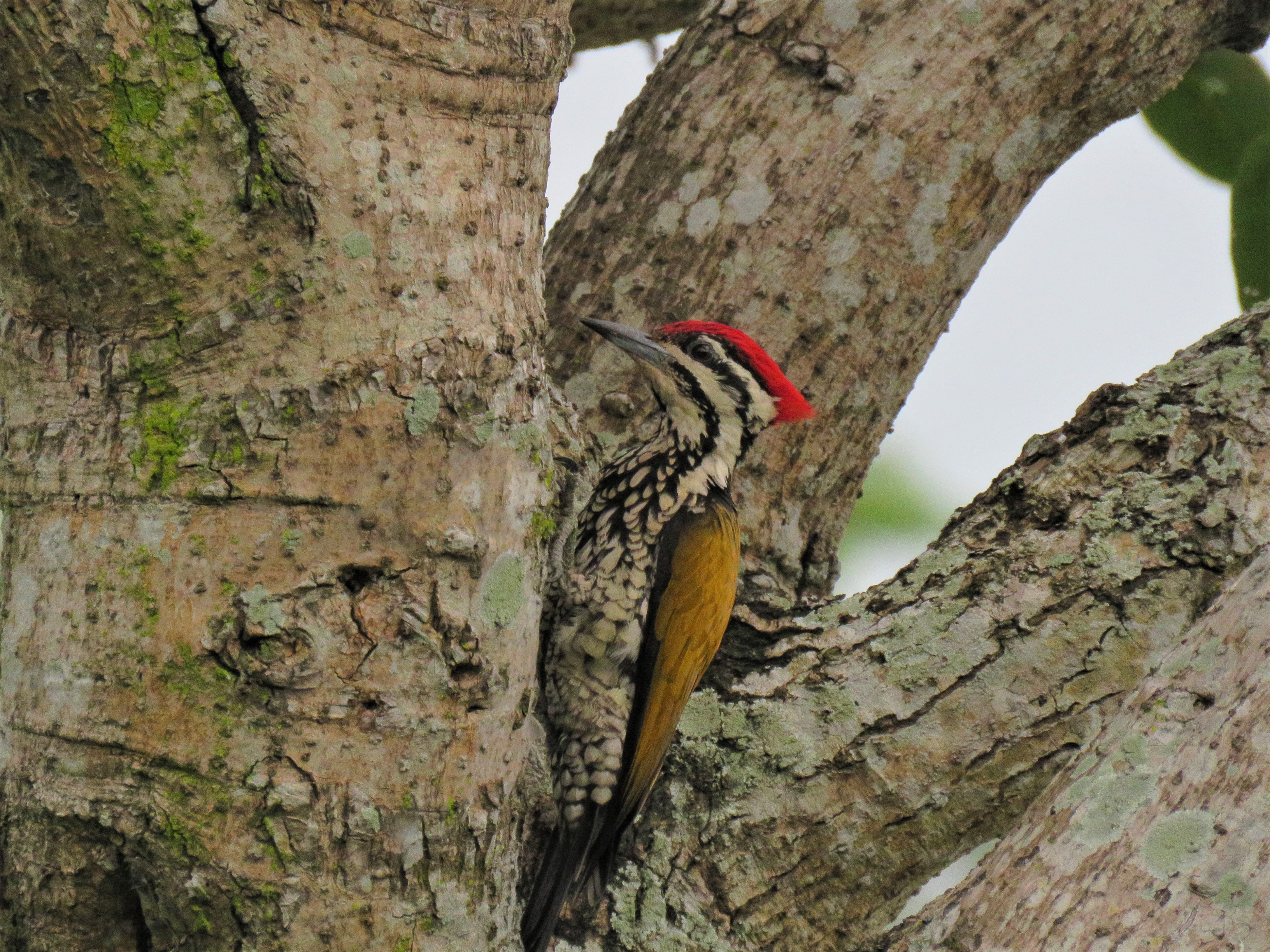
Male. Photo credit: Ruth Tan (NParks)
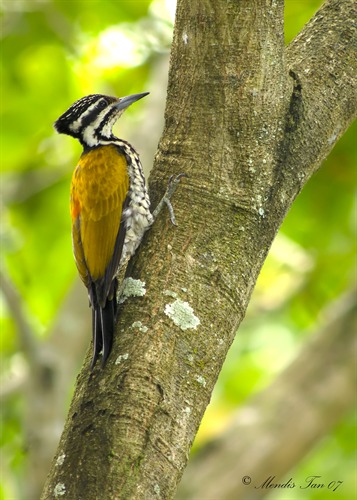
Female. Photo credit: Mendis Tan, NParks Flora&Fauna Web
|
Scientific name: |
Dinopium javanense |
|
Common name: |
Common Flameback |
|
Family: |
Picidae |
What does it look like?
The Common Flameback is one of the most commonly seen species of woodpeckers in Singapore. A key identification feature is its namesake golden yellow back, which both sexes have. Males have a bright red crown, while females have a black crown. Its loud, repetitive call is also distinctive.
Ecology, Habitat and Distribution
Diet and Behaviour
Besides insects, they also feed on fruits like Rambutan and Chempedak. Males are highly territorial, even confronting Plantain Squirrels when they get too close for comfort. They dig their holes 3-10 m above ground, usually in dead branches or snags.
Where is it found?
The Common Flameback is found in a variety of habitats and is usually seen in pairs. It breeds from February to July and is found from the Indian subcontinent to southern China and Southeast Asia.
Did you know?
The Common Flameback keeps parasites off its body by applying tree sap
to its feathers!
Rufous Woodpecker
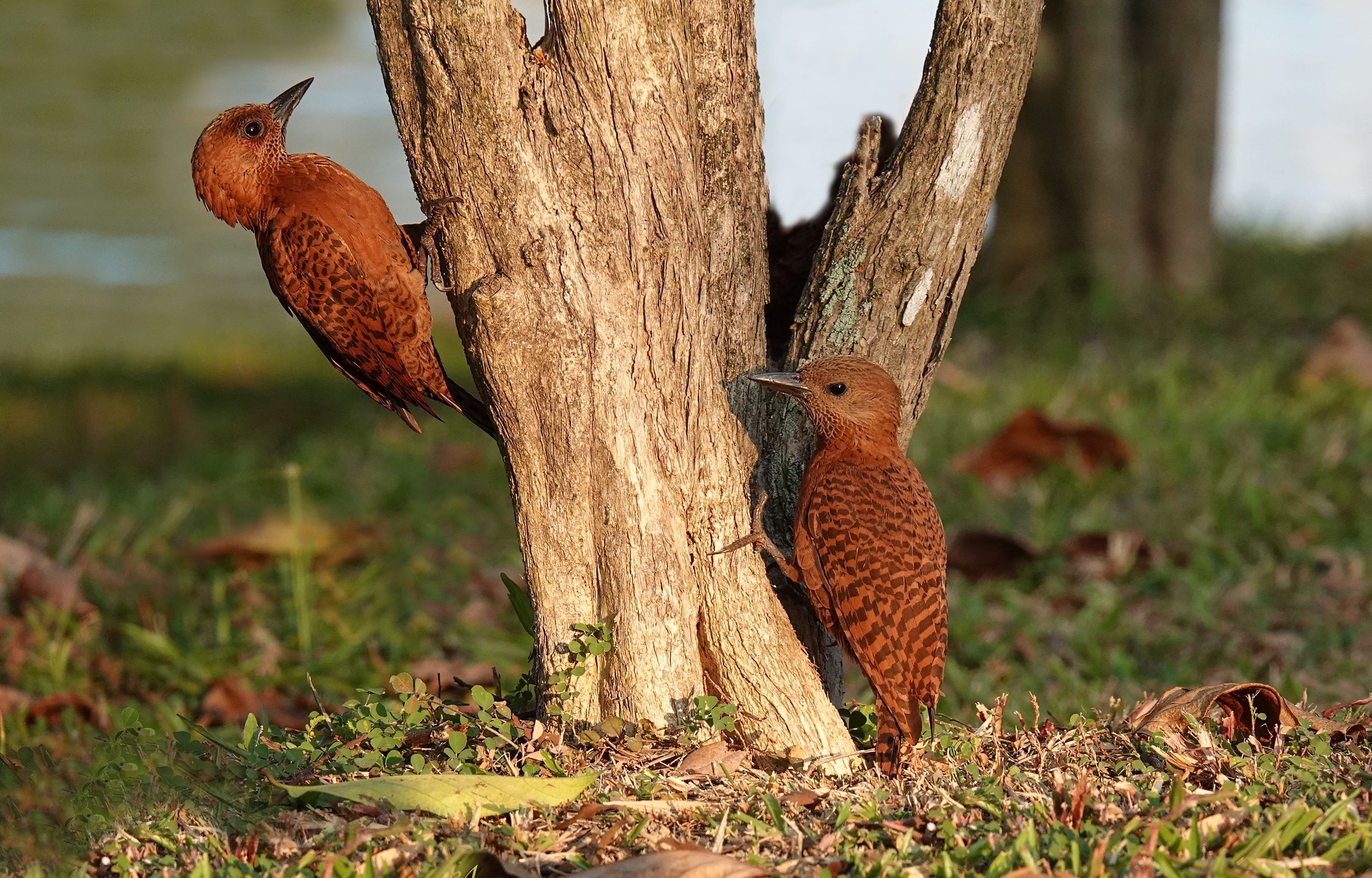
Photo credit: Tan Yip Cheong
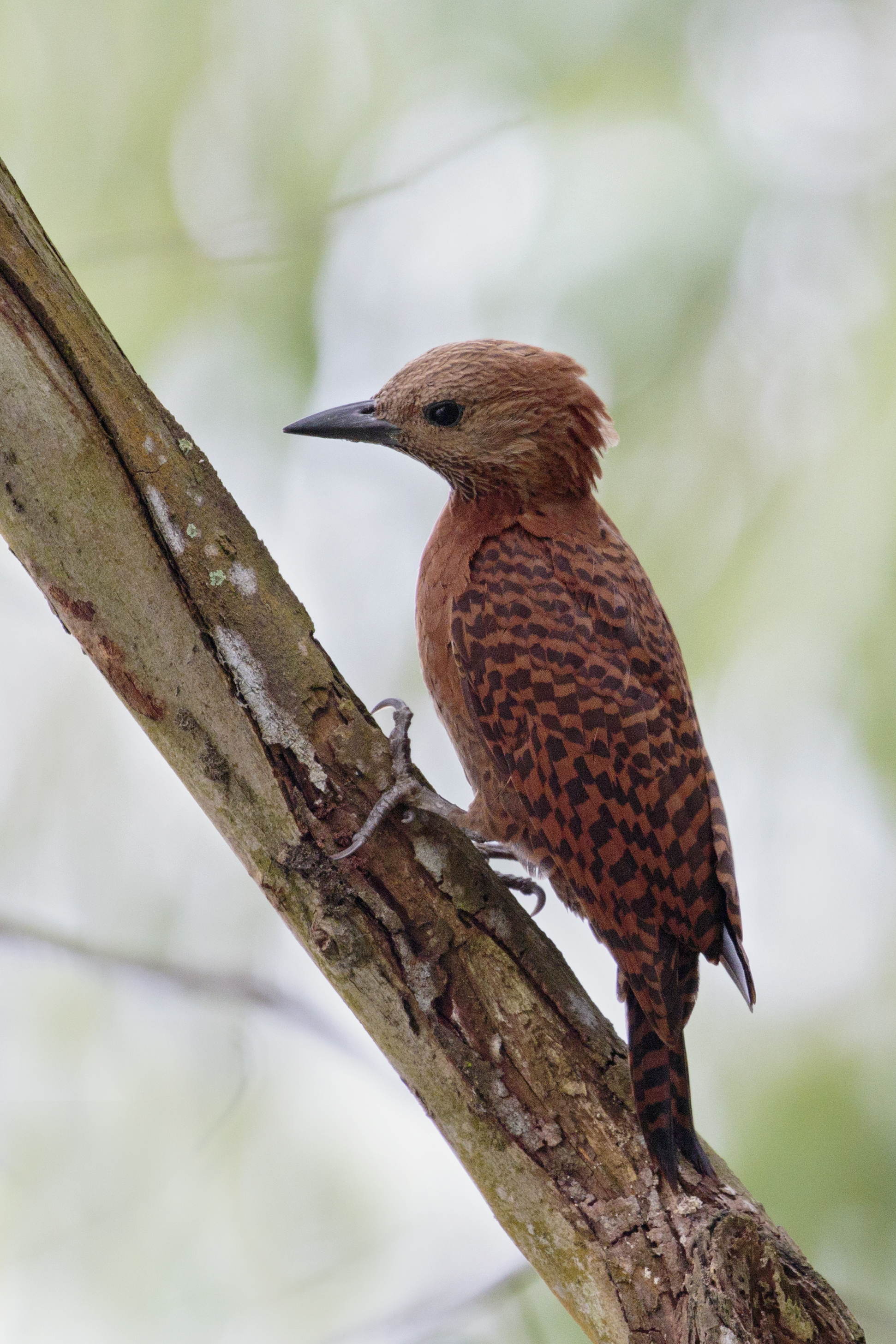
Photo credit: Loke Peng Fai
|
Scientific name: |
Micropternus brachyrus |
|
Common name: |
Rufous Woodpecker |
|
Family: |
Picidae |
What does it look like?
It is not commonly found in Singapore. It gets its common name from its uniformly reddish brown plumage, which distinguishes it from other species of woodpeckers in Singapore. Males have a small red cheek patch, which females lack. Its call is a rapid series of seven to nine laughter-like ‘hee’ sounds.
Ecology, Habitat and Distribution
Diet and Behaviour
They forage in pairs on ant nests, trees and fallen logs. They are known to consume nectar from Erythrina trees too. They have an unusual symbiotic relationship with tree ants whereby they build their nests within the ants’ nests, but feed on ants from other nests.
Where is it found?
The Rufous Woodpecker is found in forested areas and well-wooded parks such as Jurong Lake Gardens, Tampines Eco Green, and Pulau Ubin. Outside of Singapore, it can be found from southern China and eastern India to Southeast Asia.
Laced Woodpecker
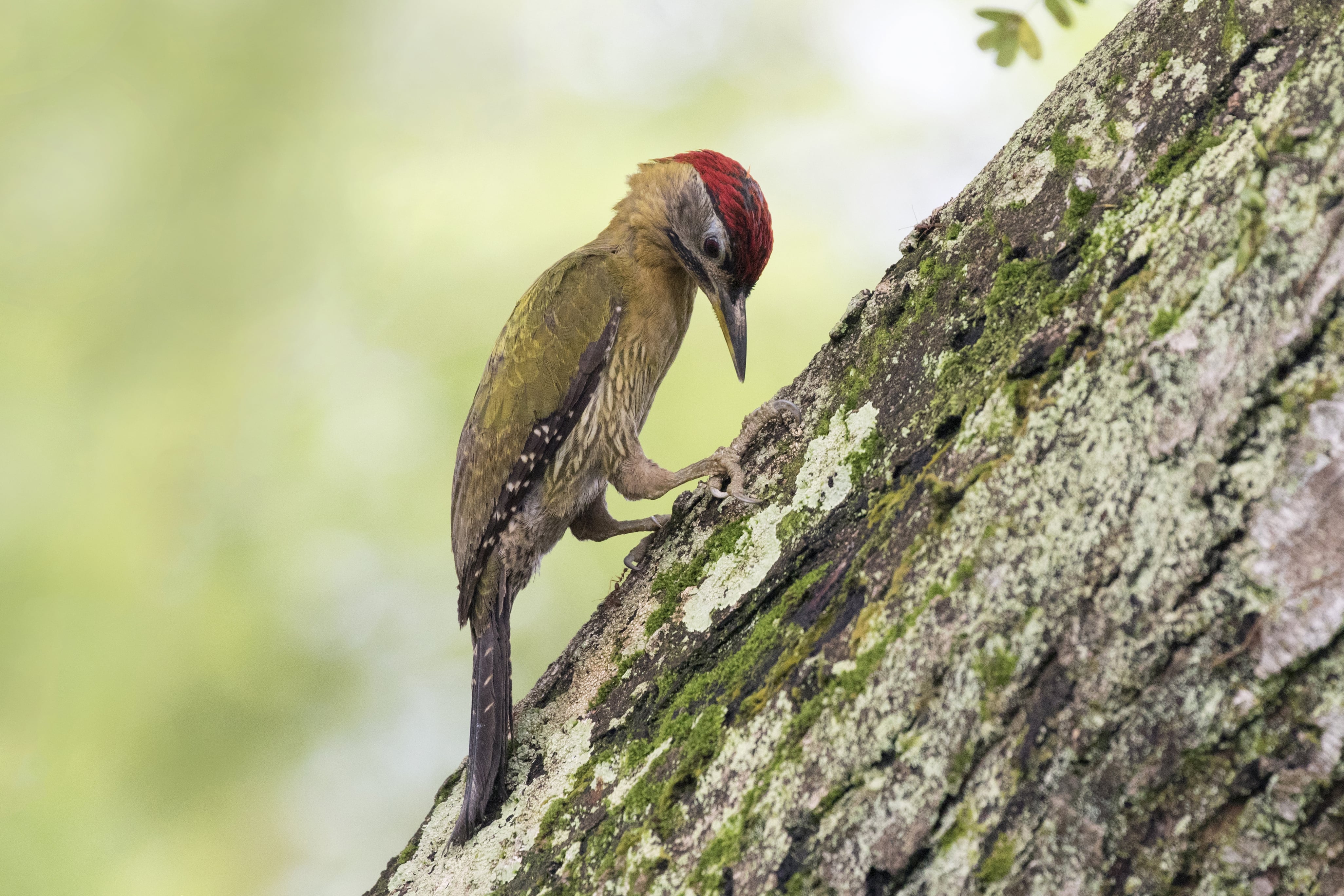
Male. Photo credit: Loke Peng Fai
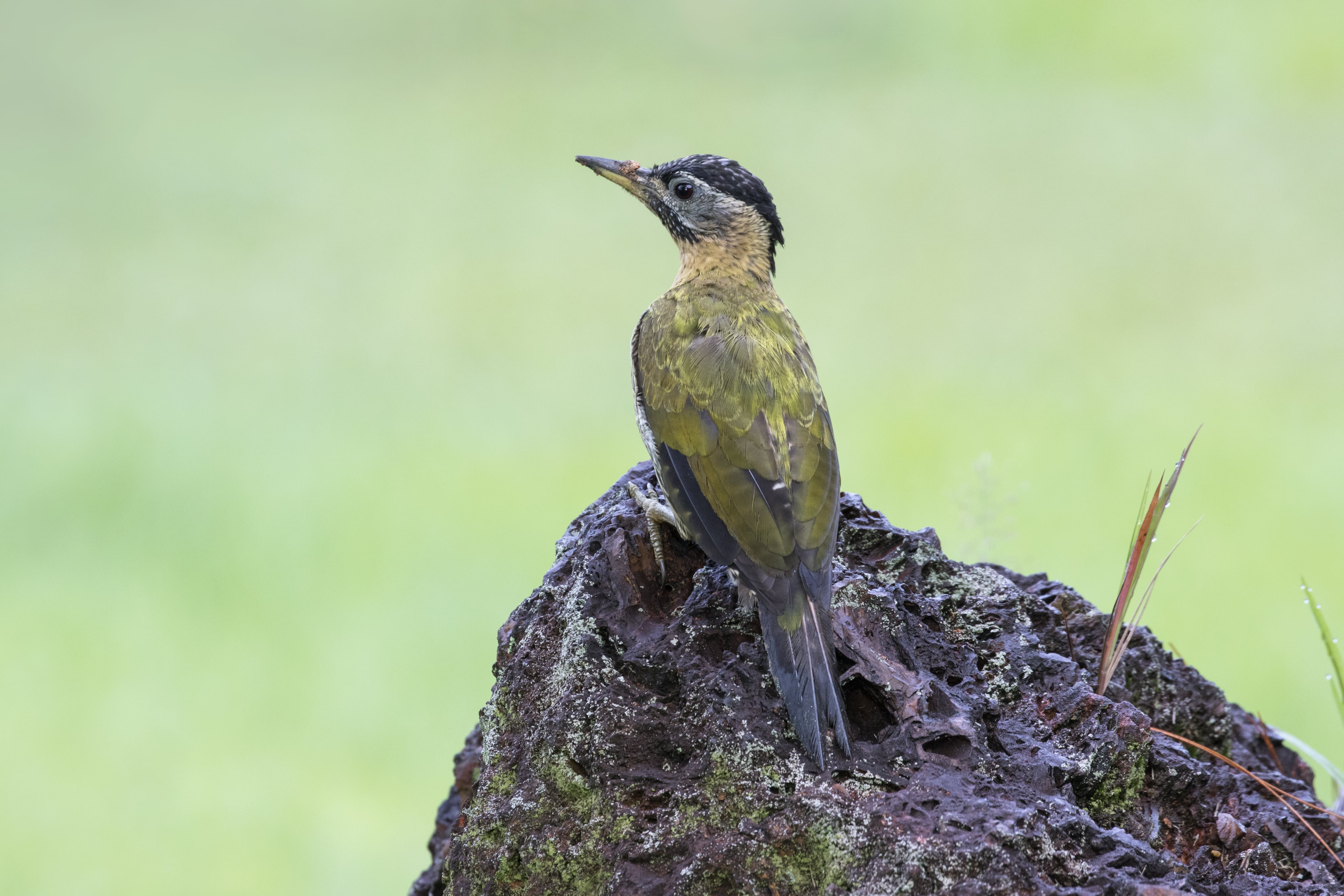
Female. Photo credit: Loke Peng Fai
|
Scientific name: |
Piccus vittatus |
|
Common name: |
Rufous Woodpecker |
|
Family: |
Picidae |
What does it look like?
Its larger size, predominantly green plumage and grey face distinguish it from other woodpeckers in Singapore. Like the Common Flameback, males have a red crown while females have a black crown. Its call is a series of short ‘kek’ notes.
Ecology, Habitat and Distribution
Diet and Behaviour
It forages for insects at lower heights than other woodpeckers, even occasionally descending to the ground. It is usually seen alone or in pairs.
Where is it found?
The Laced Woodpecker is commonly found in wooded habitats like secondary forests, old plantations, mangroves and well-wooded parks. It was previously recorded nesting at Chinese Garden. Its global distribution ranges from southern China to Southeast Asia.
Did you know?
It has been observed feeding on durian by sticking its long tongue into
the fruit through an opening made by a Plantain Squirrel!
Sunda Pygmy Woodpecker
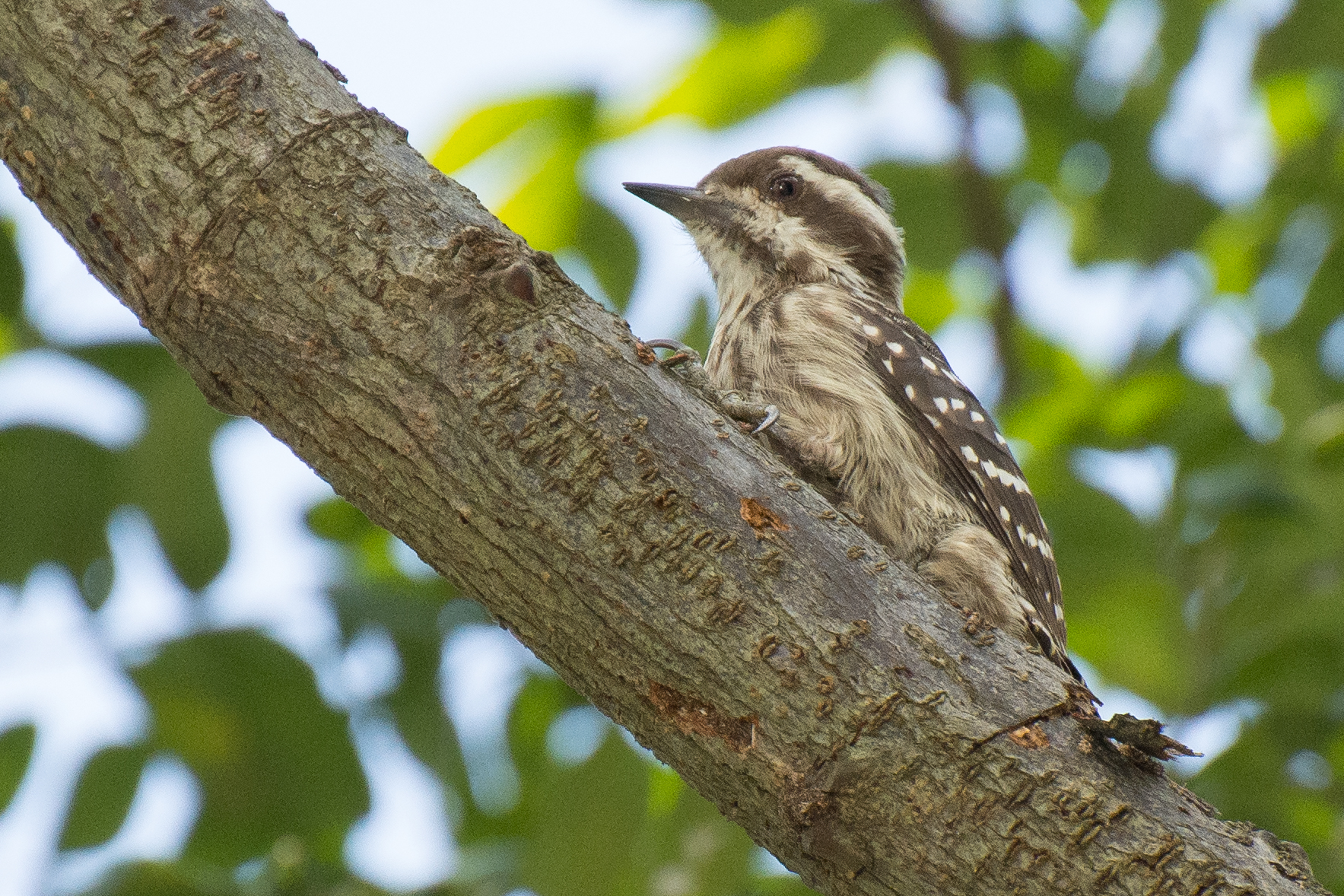
Photo credit: Dillen Ng (NParks)
|
Scientific name: |
Dendrocopos moluccensis |
|
Common name: |
Sunda Pygmy Woodpecker |
|
Family: |
Picidae |
What does it look like?
This tiny woodpecker has a brownish crown and ears, prominent white facial bands that narrow towards the neck, and brownish upperparts with white barrings. The male has a small red line on the sides of its head.
Ecology, Habitat and Distribution
Diet and Behaviour
It is often found singly or in pairs and often nests in tree holes. Being so small, they are soft and not easily audible even when chipping away at wood.
Where is it found?
This is the most commonly encountered woodpecker in Singapore, and can even be observed in carparks with large trees. Elsewhere, it is distributed across the islands of Sumatra, Java and Borneo.

